









28 A wrap about confectionery



32 Meat packaging pads developed from natural waste






33 Glass vs aluminium: what’s best for beer packaging?












28 A wrap about confectionery



32 Meat packaging pads developed from natural waste






33 Glass vs aluminium: what’s best for beer packaging?

The BBC has called the barcode “one of the 50 things that made the modern economy”, and rightfully so. Since its creation in 1973, the symbol is now present on over 1 billion products, and the ‘beep’ at the checkout counter of every store is instantly recognisable worldwide.
The barcode has changed the way we have shopped over the past 50 years. Although all barcodes may look pretty similar, the power lies inside, with a simple scan connecting a physical product to digital information that flows across the entire supply chain thanks to global standards.
The organisation behind the barcode and its global standards — GS1 — has evolved over the last five decades from a standards organisation towards a standards and services organisation currently present in 116 markets.
As the barcode turns 50, GS1 is now launching a global transition from traditional barcodes to next-generation barcodes that may once again change our lives in new ways.
“As consumers rightly demand more and better product information, and the planet requires us all to maximise the power of data for smart and efficient decisions, we are now launching a global transition from traditional barcodes to next-generation barcodes and we welcome everybody on board for this journey,” a GS1 spokesperson said.
Next-generation barcodes, such as two-dimensional QR codes, can capture large amounts of data for businesses, regulators, consumers and patients, offering more than just links to web pages. They may tell a product’s story, its origins, if it contains allergens, if it is organic, how it can be recycled and what its environmental footprint is. This transparency will help people make decisions about what they buy and use.
GS1 is building a coalition of industry leaders to deploy next-generation barcodes globally, putting technology at the service of efficient trade, more sustainable shopping and patient safety.
It launched a global initiative to transition from traditional to next-generation barcodes with key players in the retail sector at the end of 2020. Over 20 countries and districts, including Australia, China and Brazil, have already started successful pilots. In 2021, GS1 China promoted 2D barcodes and 20 major key branches, including the Zhejiang Branch of GS1 China (Zhejiang Institute of Standardisation), joined the project. In Australia, a 2D program designed to increase awareness, capacity and adoption is in full execution.
GS1 Australia www.gs1au.org

A correctly sized system provides a reduction in your power consumption and maintenance cost. When focusing on efficiency we look at your air demand profile to offer the right combination of compressors.

There is more than just the efficiency of a compressor. You also have to take into account dryers when designing your compressed air system. Selecting the right dryer technology can reduce your energy consumption and lower your total cost of ownership.

Our zero loss drains are automatically controlled and monitor the condensate build up with condensate level sensors - you will save both energy and compressed air.

It is important to use the right piping material and to have adequately sized piping. Using the right material avoids corrosion and leakages. This guarantees the required air quality and energy efficiency.
It not only maintains air quality and stability, but also reduces false demands. Correctly sized receiver tank then lowers the cycle time while keeping your system optimised.
Good ventilation reduces heat circulation. Waste heat can be recovered by using our energy recovery systems (to heat rooms, water or production processes).
A small leak can easily increase your compressors electrical costs by 15-20%. It is crucial to rapidly detect, repair and avoid leakages in your system.
Having a central controller reduces the average pressure band, controls the capacity and regulates the speed. It reduces your energy cost by reducing energy usage and air leakages.
Saputo Dairy Australia (SDA) has announced a $20 million investment in its Smithton plant in Tasmania.

News of the factory expansion in north-west Tasmania follows the company’s consolidation initiative in Victoria and South Australia announced late last year.
In November 2022, SDA announced it was permanently closing its Maffra, Victoria, facility this year (2023) due in declining milk supplies. The company said it will also scale back activities at two other facilities by shutting down its bulk powders production area located in Leongatha, Victoria, and closing its cheese packaging area in Mil-Lel, South Australia. The Tasmanian facility expansion is expected to be used to manufacture high-value dairy products, including frozen cream cheese which was previously manufactured at the Maffra facility.
Norco has won two awards at Dairy Australia’s Grand Dairy Awards 2023, with its Pure Jersey Milk named Champion in its category and its Real Iced Chocolate receiving the same accolade. The judges of the awards worked through 320 products spanning 18 categories — the Norco products were awarded for their quality and taste.

Ben Menzies, Norco General Manager of Commercial & Strategy, said it is an honour to receive the awards.
“It’s an absolute honour to be recognised on a national scale for our talent, hard work and the positive contribution we continually give back to our industry — which is the driving force behind everything we do,” Menzies said. “It’s wonderful to be recognised as dairy champions and Australia’s finest but it’s also a celebration of our 100% farmer owned co-operative, its people and our farmer members.”
The awards began in 1999 to recognise excellence and innovation in Australian dairy produce and celebrate the producers behind the products. To enter, manufacturers must receive the gold medal at the qualifying competitions and have products made from Australian milk. Champions are the highest scoring product of each class and finalists are the top three products in each class.
Norco Lactose Free Lite Milk and Norco Real Iced Coffee Triple Shot were awarded as finalists in their categories this year.

Food Standards Australia New Zealand (FSANZ) has updated Safe Food Australia to incorporate the new Standard 3.2.2A Food safety management tools, which comes into effect December 2023. The updated guidance was part of a suite of initiatives developed with states and territories to support strengthened food safety and protect public health and safety.
Food services, such as cafes and restaurants, is vital to the Australian economy. Many of these businesses already provide Australians with safe food.

According to FSANZ CEO Sandra Cuthbert, the key changes are the training requirements for food handlers and supervisors. There is also guidance for substantiating key actions at critical points known to manage food safety risks.
“I am pleased federal, state and territory governments are taking a joint approach to improving food safety standards across Australia and appreciate food businesses’ cooperation in ensuring consumers continue to have high confidence in the safety practices of the foodservice and retail sector,” Cuthbert said.
The changes come into effect 8 December 2023. Food businesses may contact their local enforcement authority for further information about compliance with the new standards.

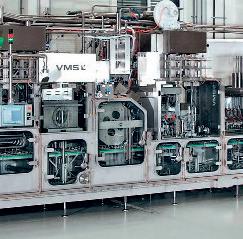



Invented and founded in Berne, Switzerland in 1908 by Theodor Tobler, the Toblerone chocolate brand is well-known for its distinctive triangular peak shape and honey and almond nougat taste. According to the owners Mondelez, the brand has a rich history and many loyal fans around the world — and demand for it is growing.

In order to meet the increased demand, some of the production will soon be changed and as a result the chocolate’s packaging design will no longer meet the requirements of the Swissness legislation, which was introduced in 2017.
In order to be called a Swiss food under the Swissness legislation, 80% of the weight of the raw materials concerned must come from Switzerland and the essential processing must also take place in Switzerland. For milk and milk products, there is also a special regulation that states that 100% of milk as the raw material must come from Switzerland.

If a product doesn’t meet these requirements, it cannot use any Swiss national symbols, such as the Matterhorn Mountain, or the “Made in Switzerland” designation to promote it.
According to a Mondelez spokesperson: “For legal reasons, we have to adapt our packaging to the Swissness legislation and, among other things, remove the Swissness notice on the front of the Toblerone pack. The Toblerone bars are still and will continue to be produced in Switzerland.
“The redesign of the packaging introduces a modernised and streamlined mountain logo that is consistent with the geometric and triangular aesthetic. The famous hidden bear is retained. The other changes to the packaging also reflect Toblerone’s heritage: the font and brand logo are inspired by the Toblerone archives and include the signature of our founder Tobler.
“Berne plays a central role in Toblerone’s history and will continue to do so in the future. That is why we have invested significantly in Berne over the last five years to modernise the factory, increase productivity and competitiveness, and meet changing consumer needs smarter and faster. These investments will enable us to increase production of our 100 g Toblerone bars in Berne in the medium to long term, ultimately producing 90 million additional 100 g bars per year.”
More of Australia’s iconic Allen’s lollies will now be made in Victoria, thanks to a $12m expansion of Nestlé’s manufacturing site at Broadford backed by the Andrews Labor government.

The project will allow Allen’s chew lollies, including Minties, Red Ripperz and Sherbies, to now be manufactured in Broadford, adding more than 2000 tonnes of products each year to the factory’s current production.
The Allen’s brand is owned by Nestlé Australia and has been produced in Broadford since 1982, with the factory now operating 24 hours a day, five days a week.
Nestlé Broadford Factory Manager Emily Bradbury said: “We’re proud to make Australia’s favourite lollies right here in Broadford, thanks to our hard-working team. Our expanded facilities will allow us to scale up production — which is good news for lolly lovers, and for Broadford.”
The Allen’s factory is the largest private employer in Mitchell Shire and the project is set to create nine new jobs and provide long-term job security for more than 200 existing employees.
Food manufacturing is one of the biggest industries in the Goulburn Valley, growing 15% faster than the Victorian average for industry growth.
Minister for Regional Development Harriet Shing said: “Goulburn Valley is a food manufacturing powerhouse, and this investment is another example of what we’re delivering in the region — a strong economy, powered by secure jobs.”



Following the first day of the Australian Institute of Packaging’s (AIP) Australian Packaging Conference in Melbourne, the 2023 Packaging Innovation & Design (PIDA) Awards were held. With sustainable solutions a major focus, the Sustainable Packaging Design of the Year award was split into five categories:
1. Recycled Content
2. Labelling
3. Mono Material Advancements
4. Renewable Materials

5. Compostables
This year, foodpro is partnering with the AIP to bring education on responsible practices when it comes to food packaging. As such, many winners in innovative packaging or processing solutions that incorporate sustainable practices will be exhibiting at foodpro 2023.

The winner of the labelling category was Herma InNo Liner Labelling by Result Group and Hanes Australasia. It is a completely recyclable labelling system that does not contain any liner material, enabling less waste, reduced shipping costs and increased carbon footprint benefits.
Detpak (as part of the Detmold Group) and Woolworths Supermarkets won Bronze for Sustainable Fresh Produce Packaging. The DualPakECO dual ovenable trays by Confoil in collaboration with BASF won Gold in the Compostables category. The trays are certified compostable to Australian standards and an alternative to PET packaging for ready-to-eat meals. Result Group, Detpak and Confoil will exhibit these products at foodpro 2023, which is being held at Melbourne Convention & Exhibition Centre from 23–26 July.
Wayne Driver, Managing Director of SMC Corporation Australia New Zealand, will be taking early retirement due to health and personal reasons, with effect from 1 April 2023. The timing will coincide with the start of the new SMC financial year.

Driver has been a familiar face in the industry for many years, having been part of SMC for 33 years and significantly contributing to the growth and success of the company.
“This decision has not been taken lightly,” Driver said. “I have spent many years devoted to SMC. During this time, I have had the opportunity to work in Japan, New Zealand and Australia. SMC has enabled me to visit numerous SMC subsidiaries to see their local operations and has greatly enriched my professional development. I wish to personally thank our many customers and suppliers for their part in making SMC ANZ what it is today.”
Wayne Driver’s retirement marks the end of the company’s ‘Driver’ era, as he and his father Peter have devoted a collective 75 years to the company.
Many of SMC’s staff show similar dedication to the company, with 28 employees recently receiving service awards ranging from five to 40 years, a collective total that adds up to 500 years of service.
The role of Acting Managing Director will be taken on by.Simon McDonald, SMC Australia New Zealand’s current CFO/Finance and IT Director, and Board Director.
“Simon started with SMC five years ago and as a trusted member of the leadership team has collaborated across all departments. He has been instrumental in the company’s focus on streamlining processes, possesses a strong knowledge of the market and a clear understanding of SMC’s global directives and goals,” Driver said.
McDonald said he looks forward to achieving growth goals with the team and ensuring continuous improvement within the company.
“On behalf of our people, I wish Wayne and his family all the best for the future,” McDonald said.
Jackie Jarvis, Minister for Agriculture and Food, and Don Punch, Minister for Regional Development, launched the Food Innovation Precinct of Western Australia (FIPWA) during the Shire of Murray launch event.
Murdoch’s Food Science and Nutrition campus is part of FIPWA and establishes a destination for food professionals and researchers committed to advancing knowledge and production of food.

Under the guidance of food scientist Vicky Solah, the campus has already graduated its first class of Bachelor of Food Science and Nutrition students.
“This is a really exciting development for food research in Western Australia as it embeds our students and scientists within an established business precinct in the Peel region,” Solah said.
Solah’s research sits at the interface between food and nutrition science with an emphasis on linkages between food composition and structure, how food is processed and human nutrition.
“This new campus puts us shoulder to shoulder with the very food and beverage enterprises that we’re training the next generations of workers to join,” Solah said.
The centre focuses on high-impact areas in the industry, including extending the shelf life of food without compromising nutrition and flavour, developing new food and beverage products and nutritional profiling of foods and sensory evaluation.
Ahead of the launch, Solah and her team used the new position to connect PhD researchers with industry in collaborative dairy and horticulture research.
One of these projects was with Bannister Downs Dairy.
“Our research collaboration with Murdoch’s food science and nutrition team in 2022 confirmed what we suspected — Western Australian milk is nutritionally different,” said Suzanne Daubney, Managing Director Bannister Downs.
This collaboration presented Bannister Downs and other businesses in the industry with a scientifically proven point of difference. This type of project — proving and finding new nutritional benefits to local produce — is a major opportunity for the collaborative centre.
In an international export market that places a high value on provenance and nutrition, having scientifically proven claims are a powerful differentiator for local producers. It also sits squarely within Solah’s vision for the centre.
Murdoch’s Food Science and Nutrition campus is complemented by the Food Technology Facility (FTF) at FIPWA, which features a food manufacturing pilot plant to test innovations at batch scale to assist commercialisation.
The FTF is operated jointly by Murdoch, the Future Food Systems Cooperative Research Centre and Department of Primary Industries and Regional Development. It will assist food businesses to test, develop and produce products using advanced manufacturing technologies.
James Krahe, CEO of Future Food Systems CRC, said, “I am very excited by the potential of FIPWA to become the central location for future food valueadding in WA as well as wider Australia.”
FIPWA is managed by the Shire of Murray and made possible with funding support provided by the Australian Government and the government of Western Australia.
Mars Wrigley has announced the appointment of Kalpesh Parmar as General Manager for Mars Wrigley Asia. Parmar succeeds Patrick Gantier, who has left the organisation after 15 years to pursue other opportunities.
Parmar was the GM of Mars Wrigley India and has more than two decades of experience in the FMCG industry, working across multiple geographies in Asia, Middle East and Africa. Since joining Mars Wrigley India in January 2020, he has used his experience to drive growth while focusing on talent development and engagement.
In the new role, Parmar will oversee 20 markets in the Mars Wrigley Asia portfolio, leading operation of the chocolate, gum and fruity confections segments across all Asia markets, as well as the pet nutrition segment in South Korea, Taiwan and Hong Kong.
Parmar expressed his excitement at seeing the company expand further and outlined his goals to build on its existing brands and sustainability commitments.
“I believe this region has tremendous potential that the Mars Wrigley Asia business can help realise, to become a future growth engine for the company,” he said.
Parmar has worked in both matured and emerging markets in South Korea, Singapore, Dubai, Turkey, Nigeria and India, holding senior positions across business development, brand building, distribution and e-commerce. Prior to joining Mars Wrigley in 2020, Parmar was with Unilever for over 12 years where his last role was CEO for South Korea, Pacific Islands and Mongolia.
Succeeding Parmar in his current role will be Tamer Kadry, the current Vice President of New Markets & Future Growth for Mars Wrigley Global Emerging Markets, who has been appointed Country General Manager of Mars Wrigley India.

A poll run by foodpro has found that, with the food industry resuming pre-pandemic conditions, over 60% of businesses are looking to make capital expenditure investments in areas such as equipment and technology over the next 12 months.
The poll also indicated that 37% of respondents are looking to invest in processing and packaging, 15% in ingredients and food additives, and 13% in food science and technology.
According to Felicity Parker, foodpro Event and Product Manager, the FMCG industry experienced growth from 2020–2023. The biggest challenge for the industry during this pandemic period was capacity and supply.
In Australia, empty market shelves were a result of sea freight disruption and panic-buying behaviour. With less disruption now, supply is catching up with demand, allowing manufacturers to look towards investing.
Almost half of foodpro buyers said they were still at the information-gathering stage of investment, with 84% saying they would be attending the event with the objective of sourcing new products and services.

Having last run in 2017, foodpro 2023 will be held from 23–26 July at the Melbourne Convention and Exhibition Centre.

“With a focus on efficiency and sustainability at this year’s event, there are a host of new educational and experiential features alongside an extensive mix of exhibiting suppliers,” Parker said.
“Food and beverage processing is Australia’s largest manufacturing industry and is vitally important for our manufacturing future. Face-to-face interaction is the foundation of building strong relationships, and in-person events create the necessary push for business to happen and have significant ROI implications. We are looking forward to yet another hugely successful event.”
For further details about foodpro, visit https://foodproexh.com.
Food and beverage processing is Australia’s largest manufacturing industry, vital to the nation’s economic future. Taking place from 23–26 July at the Melbourne Convention and Exhibition Centre, foodpro 2023 sees the return of Australia’s longest running trade event dedicated to food production, manufacturing and distribution.
Following unprecedented disruptions and restrictions due to COVID-19, the event has returned to its scheduled rotation and will bring together manufacturers and industry leaders to gather, network and explore products and solutions in the industry as it has done for over 50 years.
The event will have eight zones for exploration, each dedicated to different steps in the food manufacturing process: Processing & Packaging, Ingredients, Food Science & Technology, Plant Equipment, Packaging Materials, Logistics & Handling, IT & Digital Factories and Government & Businesses services. Exhibitors from various sectors of the industry will be present, including meat, dairy, fresh food, packaged foods, baked goods, snack foods, beverages and frozen food. foodpro will spotlight exhibitors and suppliers with sustainability initiatives as it focuses on the impact of production on the environment and aims to improve mindful manufacturing.
Manufacturers will be given the opportunity to discover global innovations from suppliers and exhibitors and hear from subject matter experts in a dedicated Smart Food Lounge and Product Innovation Stage. The Smart Food Lounge will host drop-in presentations focusing on Smart Food, which encompasses efficiency and sustainability, covering trends, technologies and solutions to support compliance and traceability. The Product Innovation Stage will showcase next-generation product solutions and developments. foodpro has partnered with the Australian Institute of Food Science and Technology (AIFST Convention) to help bring forward the latest thinking in food technology and processing. AIFST will be hosting its annual convention during foodpro, with the theme of ‘The Science of Food — Security and Sustainability’. Taking place over four days, foodpro will also allow manufacturers to network and build connections with suppliers and industry peers at the foodpro Networking Bar, which will be open daily at the trade show, and the AIFST Networking Function, which will be after the first day of the convention.
The event will feature a sensory experience allowing attendees to discover new tastes, flavours and colours on the market as well as a digital product showcase demonstrating the innovations of various exhibitors on screens that will be located throughout the trade show.
foodpro is strictly for professionals working in the food and beverage manufacturing industry and contractors servicing these industries. Each visitor will have the opportunity to register five additional colleagues.
What: foodpro 2023
When: 23–26 July 2023
Where: Melbourne Convention and Exhibition Centre Web: https://foodproexh.com/

tna solutions has worked in collaboration with US pork snack company Benestar Brands to develop an efficient processing and packaging line for the company’s ‘rinds and cracklins’ products.
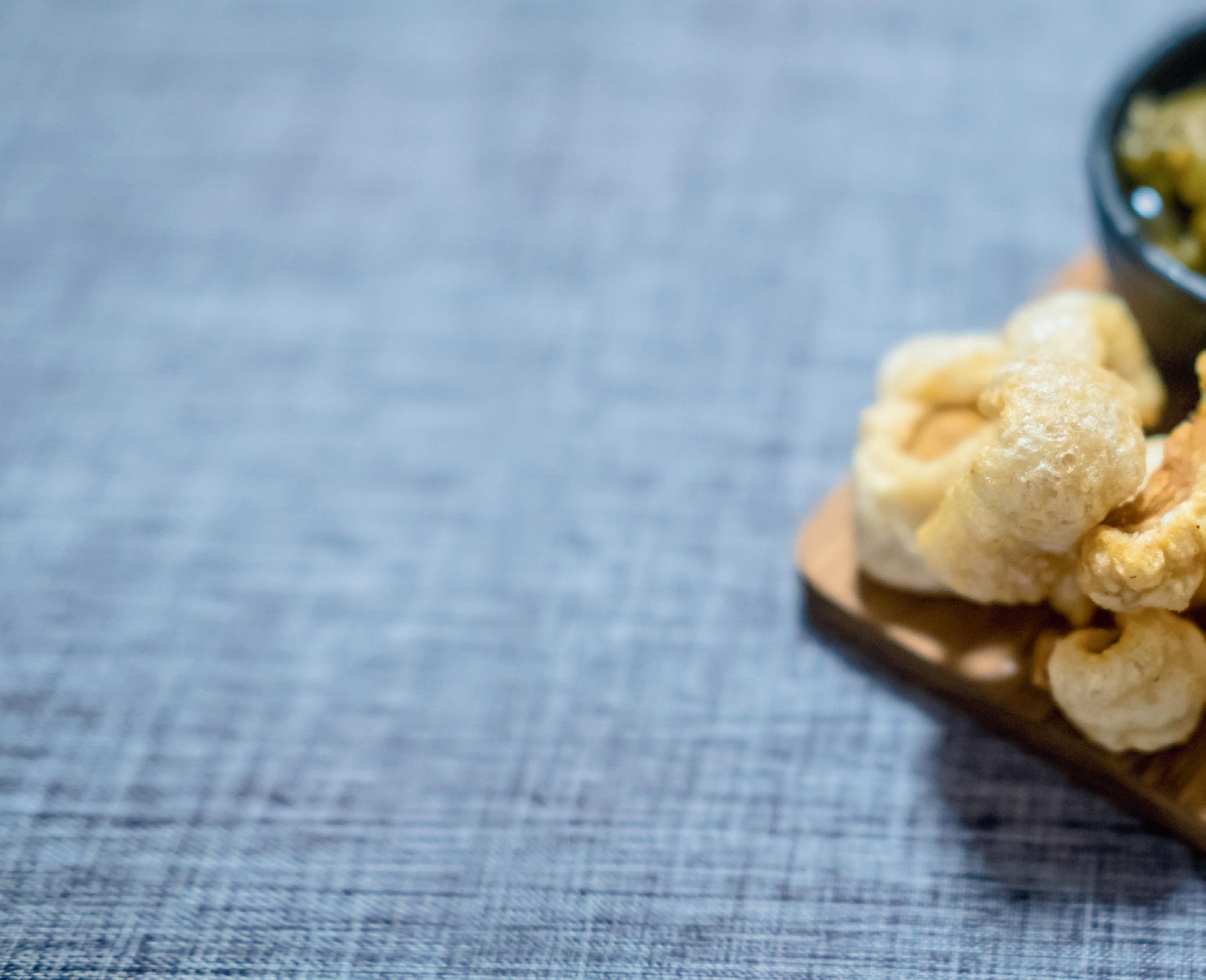
Installed in 2019, the new line from tna solutions has helped the snack company improve its product quality tenfold and extend snack shelf life, while reducing energy use and enhancing efficiency.
“tna solutions has been a fantastic partner throughout the process,” commented Jose Gomez, Chief Technical Officer at Benestar Brands. “The company’s experts have a deep understanding of our industry, while being open to listening to our specific challenges and finding out-of-thebox solutions. The accommodation of our specific needs, from footprint restrictions and frying demands to intricate seasoning, helped facilitate our partnership with tna and develop an excellent product to satisfy every pork fan.”
Working collaboratively since 2005, Benestar Brands and tna’s engineers have developed an advanced approach to pork rind manufacturing. Every piece of the process, from feeding and frying to distribution systems and packaging, is optimised to ensure better products and a faster return on investment. The tna batch-pro 12 frying technology is
designed to reduce rejects to less than 3%, while its fryer design minimises oil use, which contributes to product and material savings.
In addition, the tna batch-pro 12 fryer system provides direct-fire heating for improved energy efficiencies and lower operating costs, while the flexible tna intelli-flav OMS 5.1 seasoning system allows for consistent coverage without costly ingredient losses, further contributing to a healthy bottom line. Last but not least, the tna robag 3e vertical form fill and seal (VFFS) packaging system enabled Benestar Brands to efficiently pack both its pork rinds and cracklins on the same line at a high speed.
With a portfolio of protein-rich and keto-friendly snacks, Benestar Brands puts specific emphasis on delivering consistently high-quality product for its customers.
tna was involved in the optimisation of processing and packaging from the outset, with the pork rinds and cracklins being fully tested at its technical centre facility in Texas prior to the equipment purchase. The toughest products were put to the test to ensure a consistent texture, seasoning and flavour. tna provided guidance and technical support throughout the entire manufacturing process to help ensure the product could be brought to market quickly and efficiently.
“Our partnership with Benestar Brands has been very exciting and has fuelled the engineering innovation of our team,” said Adam Holloway, tna Regional Sales Manager, North America. “Pork rinds have very different product characteristics to traditional snacks we have been working with, such as potato and tortilla chips. We brought the years of processing experience in terms of treating food products in oil baths, while Benestar Brands contributed specific application knowledge — two key ingredients for a successful outcome.”
Achieving efficiency gains and reducing environmental impact were high on the agenda for Benestar Brands when selecting a new production line, driven by regulatory changes and increasing pressures from retailers and consumers. tna helped Benestar Brands to replace direct heating with heat exchanger technology, reducing energy use in the most energy-intensive process — frying. tna installed a LO NO x burner, reducing harmful nitrogen oxides (NO x) emissions and helping the company comply with Californian regulatory requirements.
Thanks to its three-stage oil filtration system, the continuous frying technology from tna is designed to ensure efficient oil management and turnover, eliminating the need to discard oil on a daily basis after every single production run, saving

costly material. The fryer can also lower fatty acids levels, which can help to enable an end product with the desired taste, colour, texture and nutritional profile.


With increasing pressures throughout the entire supply chain to do more to protect the environment, Benestar Brands is looking to further collaborate with tna experts on ways to reduce energy consumption, film and product waste, achieving a more sustainable production.
“The opportunities for future collaborations are endless,” Holloway said. “To meet market demands for energy-efficient and sustainable processing and packaging technologies, tna continuously invests in technological innovation, and we look forward to building a greener, more sustainable snacks industry together with Benestar Brands and Jose Gomez personally.”
tna solutions Pty Ltd www.tnasolutions.com
South East Water supports healthy and livable communities by delivering water, sewerage and recycled water services to 1.77 million people in Melbourne’s south-east. The water utility also provides water and sewer services to over 11,000 industrial customers who use water to support commercial, industrial or trade activities like manufacturing and food production.
To protect our environment and support healthy communities for generations to come, South East Water works in partnership with their customers to monitor and manage the water they discharge into the sewer, and find innovative solutions to reduce the impact of industry on our water network.
The opportunity: creating efficiencies by recovering nutrients from food production
One such customer is Lesaffre, a key global player in fermentation for 170 years with a production facility in Melbourne’s south-east where it produces high-quality baking yeast and bakery ingredients for nutrition and health.
Yeast is produced through a fermentation process using molasses, a by-product of refining sugar cane into granular sugar. Once the yeast is extracted from the molasses, the water retains a naturally dark colour and viscosity, and is high in nutrients commonly used in industrial agriculture.
As a result of this naturally occurring colour and viscosity, treating this water accounted for large amount of Melbourne’s Eastern Treatment Plant’s tertiary capacity and had the potential to limit the facility’s capability to manage the growing demand for water treatment in this key industrial and residential growth corridor.
The solution: collaborative approach for mutual benefit
Lesaffre and South East Water came together to understand the challenges and opportunities the issue presented and find a mutually beneficial solution.
Through collaboration and open discussion, Lesaffre and South East Water discovered that their interests and values were closely aligned. Both organisations are focused on supporting community health and wellbeing, being environmentally responsible and supporting innovation.
“We all came to the table with a really collaborative mindset,” said South East Water General Manager Liveable Water Solutions, Charlie Littlefair.
“I think we all understood that there was a great opportunity in front of us to not only create operational efficiencies in the water treatment process, but also to make the most of the nutrient-rich molasses derivatives in a circular economy, which is really exciting.”
The result of this collaborative approach was a new molasses extract plant at Lesaffre’s production plant in Melbourne.
The first of its kind in Australia, the molasses extract plant has the dual benefit of collecting the nutrient-rich derivatives produced through yeast production, which can then be used as food-grade mineral fertiliser for industrial agriculture, as well as significantly reducing the colour and viscosity of the water that is discharged to the Eastern Treatment Plant.

“Ultimately, anything that creates efficiencies in the water recycling process benefits our customers, community and the environment,” Littlefair said.
“Through this partnership, we’re not only supporting industry to be more sustainable, we’re also looking to pass future cost savings on to our customers and reduce the impact of operational expenses on bills.”
Lesaffre’s Australia Pacific Project Director (Agribusiness) Robert Arvier agrees that the benefits of the partnership are significant.
“Our molasses extract plant is a great tool to manufacture premium and innovative products. Through this new facility located in the heart of our production unit, we now can propose innovative and sustainable solutions to numerous technical and agriapplications whilst substantially reducing the impact of our plant on the environment and on our wider community,” Arvier said.
It’s also a long-term investment in Melbourne’s food production industry. Lesaffre has been producing in Australia for nearly 30 years, and the partnership with South East Water will support the long-term viability of the industry in Australia — providing employment opportunities and demonstrating the value of investing in local industry.
The development of the molasses extract plant process also represents an opportunity for new technical market applications across a range of industries. These include ruminant nutrition, industrial dust suppression, pelletising, cardboard manufacturing and even in dishwasher tablets.
South East Water Ltd
www.southeastwater.com.au

Based at the top of Yorke Peninsula in South Australia, Daniel Seed specialises in seed cleaning and grading for a variety of crops, primarily lentils but also wheat, barley, vetch, oats, peas and beans.
Seed cleaning and grading has become one of the most important farming practices ensuring that weed seeds, chaff, dirt and other non-seed contaminants are removed allowing for the best seeds to be sown while maximising seeding productivity.
The grading process removes only unwanted weeds and poor quality seed from each load ensuring the heavier, better quality seed remains. Larger seeds generally have better vigour and are the best start to greater yield, thereby ensuring maximum returns for the farmer.
Owner Peter Daniel was facing an issue with his production line that was operating two gravity cleaning tables fed by two individual surge hoppers. The issue related specifically to the imported vibratory feeders that were not performing to the level required both in terms of throughput per hour and flow control — both crucial factors to ensure the productivity and smooth running of the lines.
“We were hoping to get 7 tph [tonnes per hour] out of the imported feeders and they were barely managing 4 tph — they didn’t even perform to the factory specs,” Daniel said.
It was a simple Google search that led Daniel to Enmin. For over 40 years, Victorian-based Enmin has been a market leader in materials handling and vibratory equipment for a
diverse range of applications with particular expertise in the food and allied industries.
The seed specialist purchased two of Enmin’s vibratory feeders, which came with Enmin’s LD4 electromagnetic drive (which is manufactured in Australia) and a CV6 controller.
“Easy fine-tuning to regulate grain flow is critical and this is where Enmin’s controller, with its pinpoint accuracy, comes into its own,” Daniel said.
“Enmin’s product knowledge was excellent; they listened carefully to our needs to ensure we received the right solution. The quality of the product was also excellent and we found their equipment had a very good reputation in the marketplace. Being an Australian manufacturer was also an important factor for us in our purchase decision as we knew that back-up and support was just a quick phone call away.”
Installed in late January, the units are operating 12–14 hours per day and have been suitable for lentils, wheat and beans to date. “The Enmin units will ensure we achieve an 8 tph per feeder throughput, which is higher than we were originally looking for,” Daniel said.

In addition to its vibratory and materials handling products, Enmin also has a range of industrial vibrators to suit any industry that handles bulk material. The ‘Flow-Easy’ range is specifically designed to suit Australia’s environment and covers a multitude of applications.
Enmin Pty Ltd
www.enmin.com.au




Following a months-long infant formula shortage in the US in 2022, the U.S. Food and Drug Administration (FDA) has now released an Immediate National Strategy to Increase the Resiliency of the U.S. Infant Formula Market. The formula shortage happened when one of the country’s largest infant formula facilities was shut down multiple times after a significant voluntary recall of its product.
The strategy describes immediate actions the FDA took to address the shortage and it details the agency’s plans for improving the resiliency of the infant formula supply, while noting issues beyond the scope of the FDA. It also traces the events that led up to and followed the recall of infant formula by Abbott Nutrition in February 2022, the temporary pause in production at the facility in Michigan and the pantry loading that peaked in May 2022, which may have been driven in part by an overemphasis on shortages being reported in the media, as well as numerous other factors that contributed to and exacerbated the shortages.
This strategy is a first step towards issuing a long-term national strategy in 2024 to improve preparedness against infant formula shortages. With input from the National Academy of
Science, Engineering and Medicine (NASEM), the long-term strategy outlines methods to improve information sharing, recommends measures for protecting the integrity of the infant formula supply chain and for preventing contamination. It will also explore approaches to help facilitate the entry of new infant formula manufacturers to increase supply and mitigate future shortages, as well as recommend other necessary authorities to gain insight into the supply chain and risks of shortages.
Mettler-Toledo Product Inspection has launched an automated, full label inspection service for food manufacturers. The technology is designed to inspect 100% of products and shapes and identify 100% of label data and quality challenges.
The portfolio, comprising V13 Flat Pack Label, CV and CMV Combination, provides for 100% automated label inspection in high-speed production lines and can achieve documented label inspection in line with industry guidelines such as the BRCGS.
The system can be easily integrated into existing production lines, either as installation kits, standalone systems or combined with other Mettler-Toledo product inspection devices, such as checkweighers, metal detectors or X-ray systems.

The V13 Flat Pack Label Inspection carries out label inspection from the bottom up to inspect labels on the underside of flat packs. The standalone solution offers configurable material handling options and can be extended with top and side smart cameras.
The CV Combination is a fully integrated system for weight control and completeness checking combined with label inspection for all product shapes.
The CMV Combination three-in-one inspection solution delivers metal detection, weight control and label inspection in one fully integrated and spacesaving device. Its configuration is flexible and can be designed to match application needs.
Whether it’s checking the right product is in the right package, the codes are readable and the ingredients such as allergens are correct, the new label inspection offering from Mettler-Toledo can detect all non-conformity.
The offering includes Mettler-Toledo smart cameras to inspect oriented products from the side and top. The smart line scan camera inspects labels or prints on the underside of products and offers a 360° degree inspection head for checking round objects. The cameras can be mixed and matched to suit the user’s production needs and can also be used to inspect caps and lids. The software is easy to use, featuring a dedicated tool set for label inspection that helps with product set-up. Additionally, it offers Software Tooltips, which are inspection tools to intuitively guide operators through the image processing settings such as lights, shutter or focus to maximise image quality. The technology can be retrofitted onto existing Mettler-Toledo equipment for space savings.
Mettler-Toledo Ltd www.mt.com
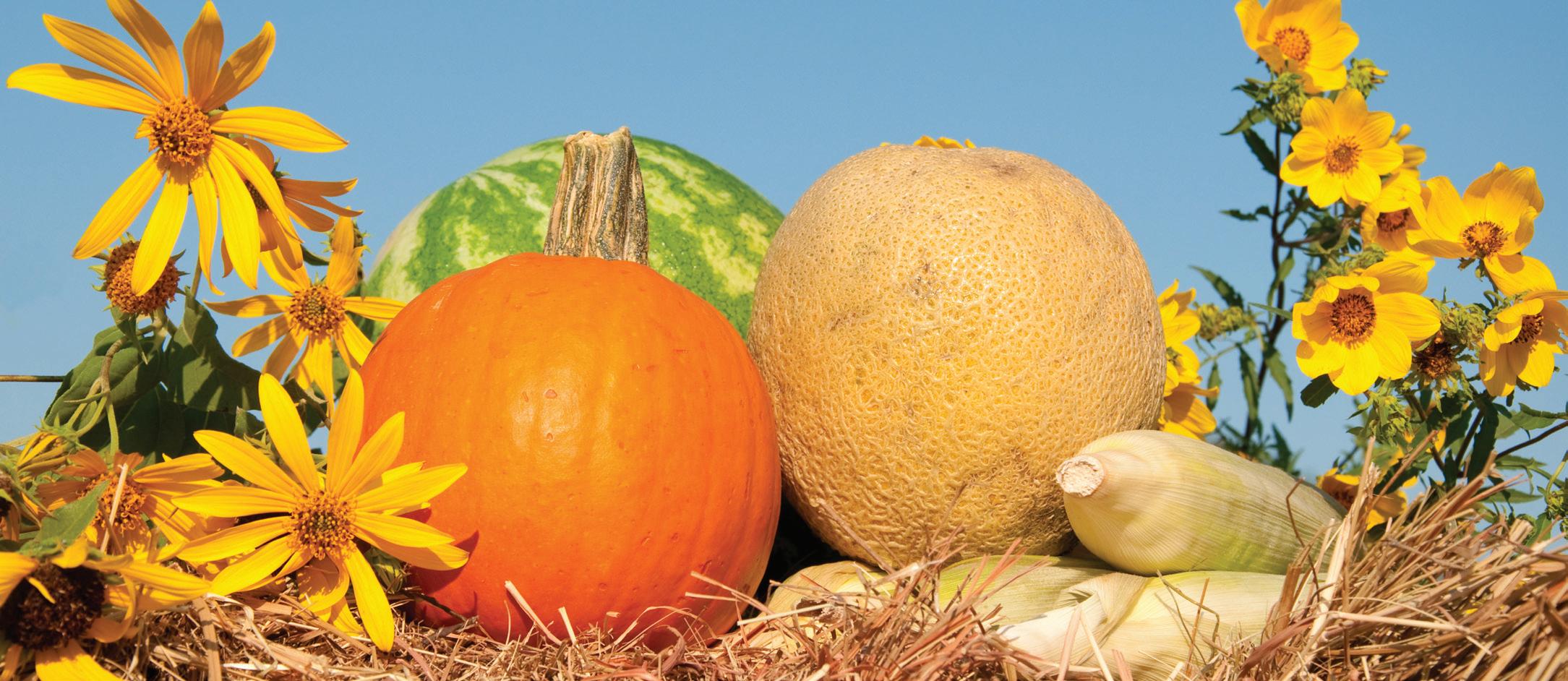


Coles Group has announced that it will acquire two automated milk processing facilities from Saputo Dairy Australia (SDA) for approximately $105 million — one processing facility is located in Laverton North (Vic) and the other is in Erskine Park (NSW), close to Coles’ distribution centres.
Each facility has the capacity to process around 225 million litres a year and they are predominantly used today to process Coles Own Brand 2 and 3 L milk.
According to Coles’ CEO Steven Cain, the acquisition will improve security of milk supply in the dairy sector, consolidate its milk production and has capacity to facilitate growth through further product innovation.
“The acquisition will build on the strong relationships we have developed with our dairy farmers since launching our direct sourcing model in 2019. Around 90 dairy farmers supply milk direct to Coles, allowing these farmers to invest for the future and ensuring the long-term sustainability of their farms,” Cain said.

“These processing facilities will complement our existing investments in our Own and Exclusive brand portfolio and manufacturing capabilities in areas such as convenience meals and meat.”
Other examples of Coles bringing manufacturing in-house include:
• the construction in 2015 of an automated retail-ready meat and poultry manufacturing facility in Erskine Park (NSW) to secure supply and improve shelf-life of meat products;
• the acquisition in 2020 of the Jewel Fine Foods (now Chef Fresh) ready-made meals facility in Mascot (NSW). Additional automation has subsequently been added to this site.
The divesture is intended to enable Saputo to further streamline its operating model, adjust its manufacturing network to strengthen market competitiveness and allow it to reinvest in areas of the business that will result in more value creation opportunities.

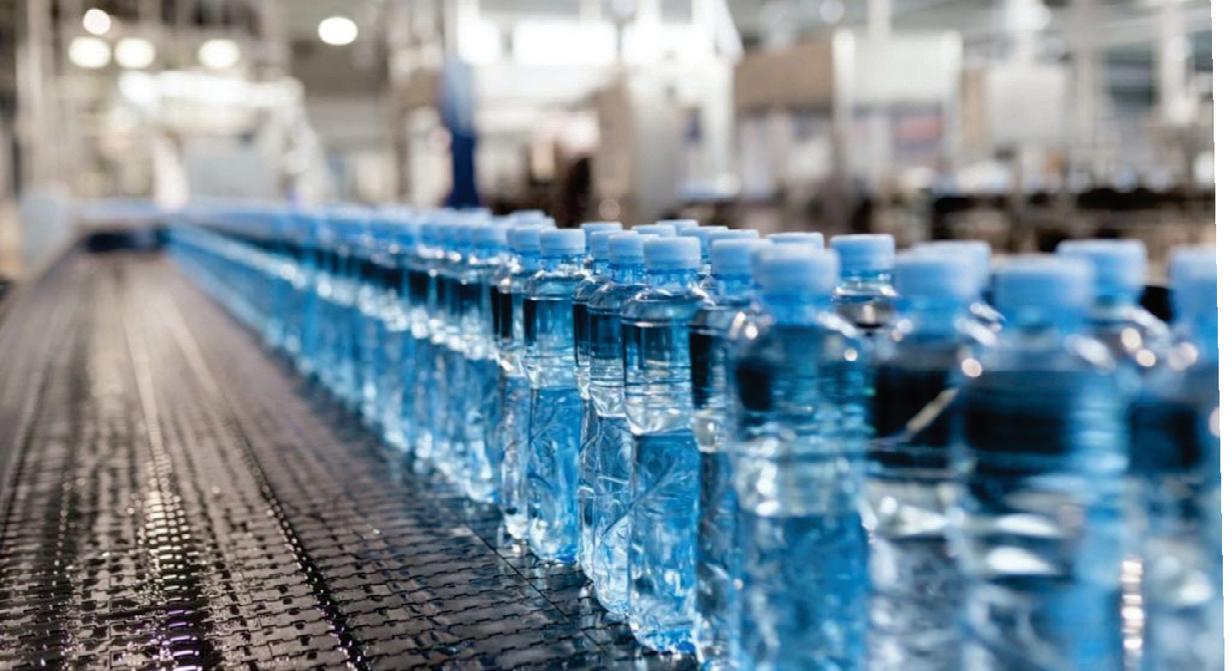


“We’re continually working to ensure we have the right manufacturing footprint and product offering to enhance our position as a high-quality, low-cost processor,” said Lino A Saputo, Chair of the Board, President and CEO. “This marks an important step in executing our long-term vision for success in Australia as we maintain a sharp focus on efficiency to ensure we maximise the return on every litre of milk.”
SDA site-based employees at both facilities will be offered employment contracts with Coles.
Coles and SDA will also enter into transitional services arrangements to ensure a smooth handover to Coles.
The acquisition will be funded from Coles’ existing debt facilities and is subject to ACCC approval and other customary closing conditions, and is expected to be completed in the first half of the 2024 financial year.

The SPX FLOW Gerstenberg Schröder Butter Bulk Packer BP5000 has been built to meet all European standards. This latest innovation provides enhancements in hygiene, safety and ease of operations for semi-solid fat processors.

The machine includes safety features such as a liner that closes before the carton leaves the machine, covered lining rolls, an enclosed packaging machine, an optional clean air filter, transparent and noise reducing safety doors and an integrated working platform for service.
The fully automated bulk packer separates semi-solid fat into individual product portions — from 10 to 25 kg cartons. While primarily used for butter, it can also be used for other types of crystallised fat, including vegetable fats and dairy blends.
For operators, the new technology can allow for better operation and maintenance and, in turn, reduced downtime, including improved automation, changeable liner rolls and flexible settings.
SPX FLOW TECHNOLOGY AUSTRALIA PTY LTD
www.spxflow.com
The MAXXDRIVE XT industrial gear unit from Nord Drivesystems provides output torques of 15 to 75 kNm with speed ratios from 6.3 to 22.4 and is offered in seven sizes for powers from 22 to 2100 kW.

The power and speed ranges of the two-stage right-angle gear unit have been specially designed for industries in which low speed ranges are required in combination with high powers, such as the bulk goods and mineral industries. Its robust design makes the MAXXDRIVE XT resistant to dirt and is suitable for use in rough operating conditions. A special sealing concept reduces maintenance, while large roller bearings and centre distances can increase the load capacity and service life of the components.
As standard, the industrial gear unit is equipped with a heavily ribbed UNICASE housing and an integrated axial fan. Due to the increased surface and the airflow covers, the cooling airflow is optimised and a high thermal limiting power is achieved. In many cases, additional cooling is not required.

NORD Drivesystems (Aust) Pty Ltd
www.nord.com
Sidel is expanding its palletising range with the introduction of the high-performing RoboAccess_Pal S. Combining the best of cobotic and robotic worlds, the unit is suitable for the food, home and personal care (FHPC) market segments.

The compact unit is designed to deliver speeds of up to 12 cycles/min and enable a case payload of up to 25 kg. It has a footprint of less than 12 m2 for two stations with a pallet height of 1700 mm.
A lightweighted carbon fibre and 3D-printed clamping head helps deliver higher payload capacity and overall machine footprint reduction while handling a wide range of secondary packaging. Additionally, the folding guarding system ensures effortless movable plug and play capabilities. A mobile physical curtain helps protect the operator during pallet supply and removal in addition to helping reduce the machine footprint further.
Sidel Oceania Pty Ltd
www.sidel.com
Strawberries specially bred for automated picking will soon become a reality in Australia thanks to a new initiative to develop bot-ready strawberries.
Scientists will meld together flavour, colour and aroma traits with premium strawberry varieties around the world that feature single-stemmed fruit suitable for robotic picking. The $11.5m, four-year effort is being delivered through Hort Innovation and led by the Department of Agriculture and Fisheries Queensland (DAFQ).
According to Brett Fifield, Hort Innovation chief executive, recent data has shown the horticulture workforce has decreased by 20% over the past three years, which has resulted in 40% of Australian growers adopting advanced machinery.
Fifield said developing a strawberry that is suitable for automation will be a game changer for growers who want to apply new technologies on-farm. Though this is not yet a common practice in Australia, it will grow in popularity.
Hort Innovation is working with tech companies and researchers on various horticulture-related automation projects, and discussions to identify opportunities for technology adoption are underway.
Jodi Neal, DAFQ principal plant breeder, said the program will reduce the time needed to pick and pack strawberries, which may result in a more profitable outcome for growers.

“It takes the same amount of time to pick a small strawberry as it does to pick a large one,” Neal said. “This breeding program is focusing on delivering a consistent fruit size
that is preferred by consumers on unbranched flower stems — meaning that the fruit can be picked faster — either by conventional methods or through automation.”
Mark Furner, Minister for Agricultural Industry Development and Fisheries, said Queensland will be at the forefront of agricultural innovation and this will create thousands of jobs in the state.
“I commend the great work of Hort Innovation and my department and look forward to seeing the fruits of this investment benefiting the industry for years to come,” Furner said.
Rachel Mackenzie, Berries Australia executive director, said the program will reduce the cost of harvesting.
“Breeding bespoke varieties to suit strawberry growers across the country is a priority for our industry,” she said. “We are looking forward to this program equipping us to profitably deliver consistent, high-quality fruit for Australians and the world.”
The Australian national strawberry industry has an estimated farm gate value of $417 million (2021/22 Australian Horticulture Statistics Handbook). Varieties developed by the Australian Strawberry Breeding Program currently capture 45% of the national market and 90% of the subtropical industry. These varieties currently provide approximately 11,000 jobs in production alone in Australia and were estimated to have a farm gate value of approximately $174 million last year. Hort
Until now, adding automation to your production line could be an expensive exercise. But Enmin’s new Generate+ systems changes all that. A range of affordable modular systems that slot easily into an existing line; reducing labour costs, boosting
productivity and improving quality. Designed and built right here in Australia they feature the same quality, reliability and safety that Enmin is renowned for. Plus, they can be added to and extended as your business evolves.

Forget that expiration date on your salmon or yoghurt. A graduate student at Southern Methodist University (SMU) has developed a miniature pH sensor that can tell when food has spoiled in real time.
Only 2 mm in length and 10 mm wide, the compact sensor can be incorporated into current food packaging methods, such as plastic wrapping. Typically, bulkier meters are used to measure pH levels, which are unsuitable for incorporating into food packaging.

Khengdauliu Chawang, PhD student at SMU’s Lyle School of Engineering and lead creator of the device, said the sensors work like the small wireless radio-frequency identification devices inside luggage tags at airports. “Every time a food package with our device passes a checkpoint, such as shipping logistics centres, harbours, gates or supermarkets’ entrances, they could get scanned and the data could be sent back to a server tracking their pH levels.
“Such configuration would allow continuous pH monitoring and accurately detect freshness limits along the entire journey — from farms to consumers’ houses,” Chawang said.
The Institute of Electrical and Electronics Engineer’s (IEEE) Big Ideas competition at the 2022 IEEE Sensors Conference awarded Chawang with the Best Women-owned Business Pitch for her invention, which she built with the support of J.-C. Chiao.
Chiao, who joined the SMU faculty in 2018, is recognised for his research in using electromagnetic waves in medical applications including closed-loop pain management systems and gastric motility management.
Food freshness level directly correlates to pH levels, which is measured by the concentration of hydrogen ions found in a substance or solution.
Because hydrogen ions are electrically charged molecules, the electrodes within Chawang’s pH sensor can detect the electrical charge generated by the concentration of hydrogen ions inside food, converting the level to pH values using what is known as the Nernst equation.
According to Chawang, the pH sensor has been successfully tested on food items such as fish, fruits, milk and honey. More testing is underway.
The pH sensor is made from a small amount of biocompatible materials and uses printing technologies on flexible films. It doesn't require expensive equipment or semiconductor cleanroom environment to produce, which can help to keep the costs low for the disposable sensor.
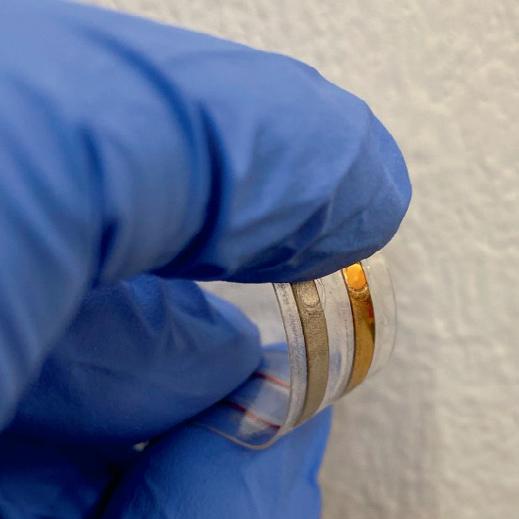
Chiao and Chawang are now testing whether the device can also be used to ensure reliable fermentation for cheese and wine. It could also have possible medical applications in detecting early warning signs of sepsis or wound infection when used on the skin.
Southern Methodist University www.smu.edu












Foodmach’s Technology Products division (FMTP) has unveiled its latest product called the Instant Palletiser, which is suitable for lower-speed and lighter-duty palletising applications in the Australian market.

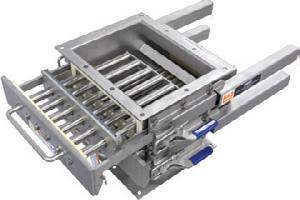



Powered by an advanced Doosan cobot, the palletiser can provide benefits for small- to medium-sized packaged goods manufacturers. The technology requires no programming, teaching or calibration, allowing for a total setup time of less than 5 min. Ad ditionally, it is completely portable, making it a versatile solution that can be easily moved into position and connected to compressed air and 240 V power.



The palletiser is designed to be safe to use and doesn’t require any safety fencing. Its maximum payload is 18 kg, including the gripper head, and it can palletise up to 1.55 m or optionally 2.5 m high. With the capacity to operate at speeds of up to 10.5 cycles/ min, it can populate two pallet locations for continuous operation.
The palletiser comes with intuitive software on a 13 ″ HMI, allowing users to enter case and pallet details and choose from the pallet pattern options provided. Once selected, the palletiser is ready to go immediately.





Instant Palletiser has been assessed by Foodmach safety experts, with a full risk assessment provided for each deployment of the solution. Collaborative robots are designed to work alongside humans and be inherently safe, with operational speeds limited to a maximum of 6.5 cycles/min, payload dependent. With the addition of optional vertically mounted zone scanners into the base of the design, Instant Palletiser can operate at up to 10.5 cycles/min.
Foodmach Technology Products foodmach.com/capabilities/packaging-technologies

As demand for sustainability grows, so does the pressure on the confectionery industry to adopt more eco-friendly packaging processes and materials for sweets and snacks. There are, however, many sustainable packaging solutions available for chocolate, biscuits, etc, which were on display at interpack in Düsseldorf from 4–10 May 2023. Visitors got to know the latest developments and trends in the sweets and snack industry. Especially in halls 1, 3 and 4, the focus was on innovative processing and packaging developments for the confectionery industry.
For manufacturers of confectionery, the demand for sustainability means that packaging processes need to be more flexible and efficient. There is a growing trend towards automated production and packaging processes, and their sweet delicacies more often come in a sustainable wrap. For example, confectionery producer Fazer now uses a light, dispersioncoated cardboard from Metsä Board for its advent calendars. The company said that switching to the new material has reduced the use of plastics by 1200 kg each year compared to the previous PE-coated cardboard. The advent calendar is now fully recyclable, and the lightweight material used has also cut its carbon footprint by a quarter.
“Virgin fibre cardboard offers the necessary safety for advent calendars, especially where chocolate and cardboard come into direct contact. Our dispersion-coated cardboard also has neutral sensory properties, which means the taste of the chocolate is preserved for a long time,” said Olli Haaranoja, Sales Director at Metsä Board.
An output of 250 bars of chocolate per minute is the rate of a new wrapping machine, marketed by Sacmi as part of the brand Carle & Montanari. It also processes new eco-friendly packaging materials. The machine is the result of a new approach to machine construction at Sacmi Packaging & Chocolate, which goes beyond traditional mechanical concepts and makes it possible to package sensitive products at high speeds and with constantly high quality. The wrapping machine produces chocolate bars with an inner and outer wrapping, where the inner wrapping is sealed on three sides while the outer wrapping is made of precut cardboard or paper. Sensors attached to the system monitor the consumption, work hours and efficiency indicators. In case of inconsistencies within the packaging process, the machine automatically issues an alert message and opens a remote connection to the service department.

A newly developed multi-style wrapping machine for chocolate truffles by Sacmi also processes eco-friendly foils. Using a top twist configuration, it wraps up to 500 chocolate truffles per minute, including sensitive products or those with irregular shapes. It is said to be the first wrapping machine with hybrid technology and not only uses mechanical, but also powerful energy-efficient servo drives. The wrapping machine is also equipped with real-time maintenance functions. As soon as the ideal settings for each motion have been defined, live diagnostics can ensure that deviations are immediately noticed and downtime can be avoided.
In a shared project, interpack exhibitors Sabic, confectionery manufacturer Mars and recycling service provider Landbell have recently developed flexible packaging for a snack bar. The monomaterial used is made up of certified, circular polypropylene from the Trucircle portfolio by Sabic. The circle starts with collecting mixed old plastics, coordinated by the Landbell Group. The mixed material is then changed by a thermal anaerobic process into pyrolysis oil, which serves as an alternative raw material for a novel PP polymer, which is suitable for contact with food. From pellets made of this substance, manufacturer Taghleef then makes BOPP films.
The northern European confectionery manufacturer Orkla has recently invested in a new packaging machine especially for chocolate products with different folding varieties by Theegarten-Pactec, to increase packaging capacity at the Finnish production site Vaajakoski. The investment was preceded by a lengthy testing phase.
“For us it was the perfect opportunity to test our packaging machine CHS first under real conditions in confectionery production. An endless stream of products, constant operation, different packaging materials and product qualities, cleaning and maintenance work during operation or even difficulties like a shutdown of processing systems — there is much that cannot be fully covered by a simulation. In the end, such tests are indispensable to give a new development the final touches and bring it to market readiness,” said Daniel Schibur, Head of Sales at Theegarten-Pactec.
Alongside general function tests, special focus was placed on the two-track feed of the machine — a specialty of the CHS. The challenge was to divert a portion of the products from the endless product stream of the main belt into the two-track feed of the CHS while at the same time making sure that an even exchange happens between the two tracks.
Each of the two feeding tracks must continually receive 900 products per minute, which are then combined in the packaging process into a one-track stream of 1800 products per minute.
An integrated camera system and effective placement of sensors now constantly check the product stream arriving at the main belt. This is designed to ensure that the two product streams in front of the machine do not differ by more than five products. The machine can be flexibly switched to nine different folding varieties: double twist, protected twist, top twist, side twist, tin foiling, bottom fold, side fold, Vienna fruit fold and — right now — envelope fold.
Theegarten-Pactec has also partly acquired the Turkish mechanical engineering company Makrev Packaging. The company based in Istanbul produces clocked wrapping machines for chocolates and jellies, as well as entire automated and feeding systems.

As with everywhere in the food industry, foreign bodies are absolutely not wanted in sweets or snacks. Modern inspection systems are therefore designed to ensure safety for today’s packaging machines. For example, a new X-ray inspection system by Mettler-Toledo was developed to detect foreign bodies in small, individually wrapped snacks and sweets at high production speeds. It allows for cost-efficient inspection right after flow wrapping or sealing individual products. The compact inspection system is equipped with an integrated ejection mechanism and supports operation at belt speeds up to 120 m/min. This makes it possible to adjust X-ray inspection to the high speeds of many tubular bag or sealing machines, which are used in the confectionery industry for packaging individual products, the manufacturer said. Even very small foreign bodies are detected with a high degree of accuracy. And as individual bars rather than entire sales units are checked right after leaving the tubular bag machine, and ejected if needed, there is also a saving of costs.
For more information about the interpack event, visit: https://www.interpack.com.
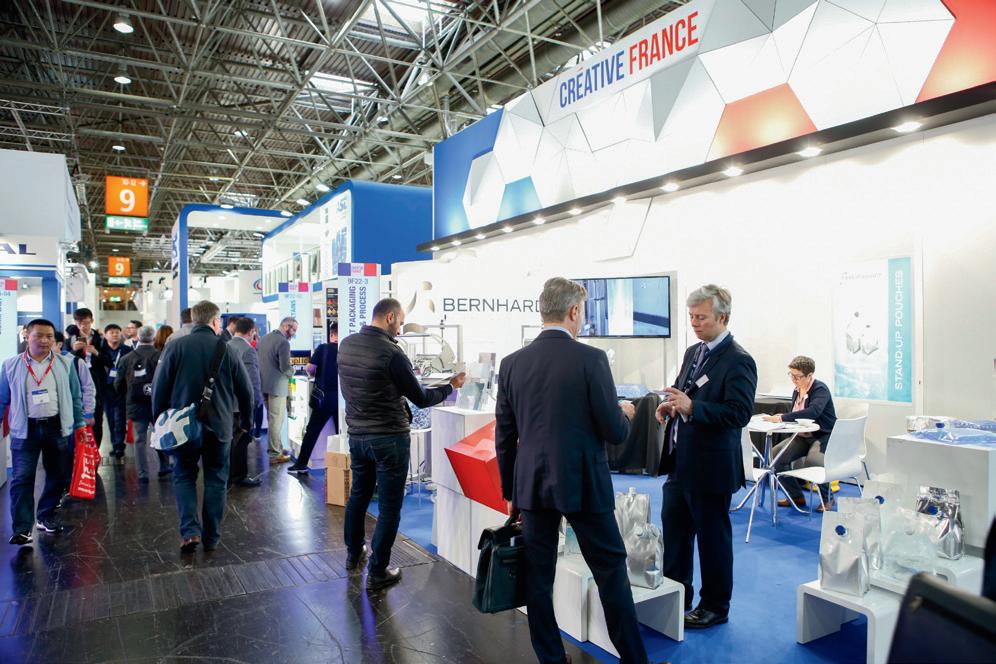
A manufacturer of closures for wine, spirits and beer, Interpack is now producing Metal Twist Caps for the food industry. Manufactured from start to finish at Interpack’s Australian facility, the products are available in a range of finish options — from a simple metallic, single- and multi-colour to full-colour photographic printing and specialty varnishes.

All caps incorporate high-quality materials, BPA-free coatings and the option for PVC-free lining and Bluemint reduced CO 2 steel.
Available in sizes 38, 53, 58, 63 and 70 mm, the caps come with the option of a tamperevident button.
Interpack is claimed to be the only Australian manufacturer for twist caps. It can provide a wide range of quantities, short lead times and FSSC 22000 food accreditation.
Interpack
www.interpack.net.au
Innovia Films has developed a five-layer biaxially oriented polypropylene (BOPP) film, Rayoface JB, which is high yield, high opacity, semi-solid and glossy white.
The 47 µm film is designed for pressure-sensitive labelling applications and combines some advantages of cavitated and solid films into a semi-solid film.
It has a coating receptive surface to allow for a printable topcoat and is suitable for household and personal care, food and beverage, and other consumer packaged goods sectors.
The product has EU and FDA food contact compliance.

Innovia Films Pty Ltd
www.innoviafilms.com
C-Cling, from KM packaging, is a home-compostable alternative to cling film — which is often not recycled. It is made from bio-based renewable sources and is clear, stretchy and sticky.

The product can be used to store and transport food safely, to protect and preserve the quality and taste, and for industrial use with packing produce and pallet wrapping.
It complies with EC food-contact Regulations 1935/2004 and 10/2011. It also complies with FDA regulation 21 CFR 177.1630, provided it is used subject to certain advised limitations and in good manufacturing practices.
KM Packaging Services Ltd
www.kmpackaging.com

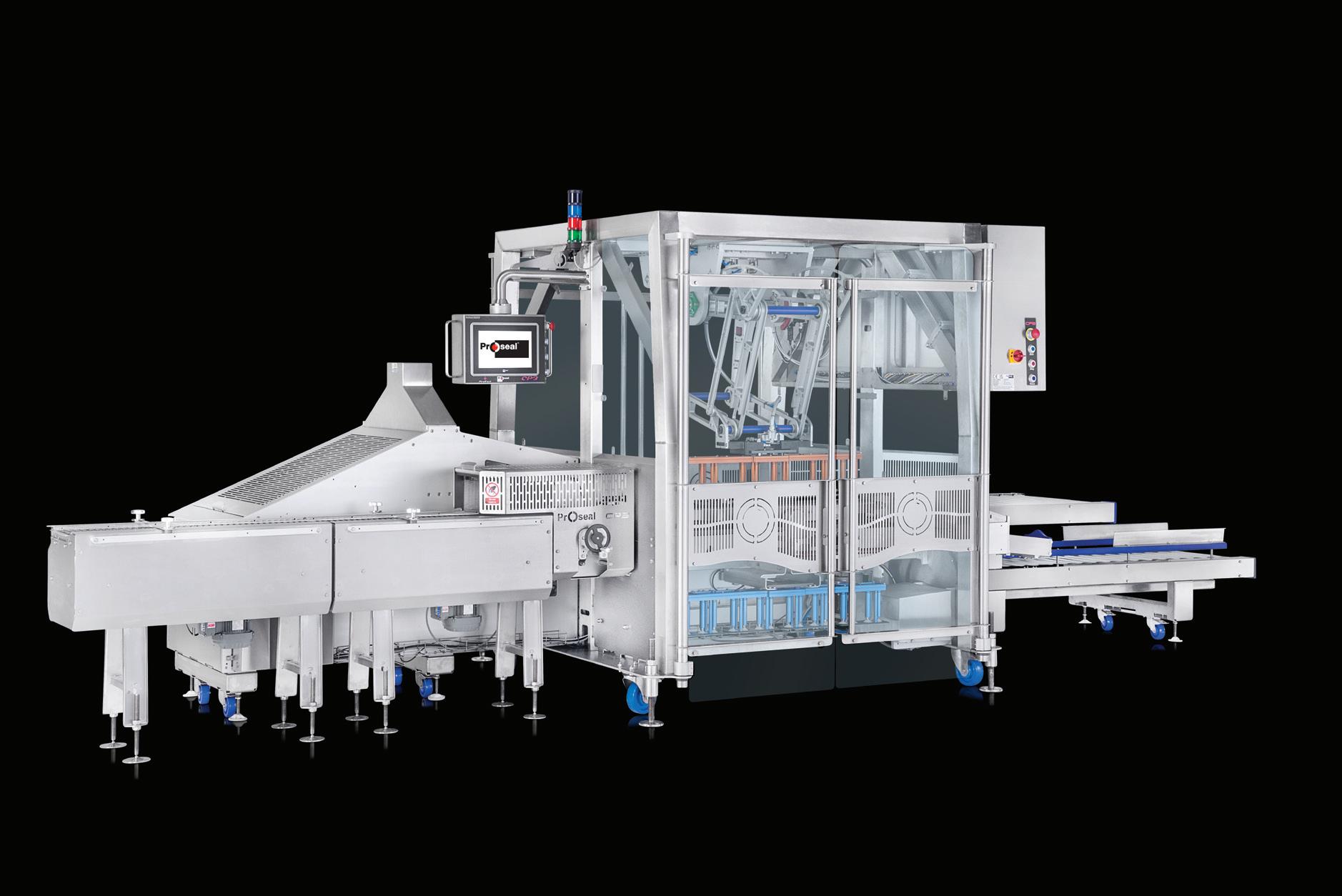



Pads incorporated into fresh meat packaging to absorb moisture and prevent food spoilage are generally composed of plastic polymers derived from petroleum by-products. In a world moving towards avoiding plastic and limiting the environmental impact, the Biopren research group from the University of Cordoba’s Chemical Engineering area has developed natural-waste padding that absorbs moisture, like conventional pads do, but also delays meat oxidation. While this is still in the concept development phase, it has potential as a circular economy solution.
Similar in shape to makeup-removing pads, the meat packaging pads — called aerogels, are composed of three basic elements. The base is made of chitosan, a polymer derived from crustacean shells. Although it is a natural polymer, the material has some functional disadvantages
Mondi has expanded its range of medium, high and very high barrier paper-based packaging, now offering a full range of FunctionalBarrier Papers. By applying different barrier technologies, such as extrusion coatings, aqueous coatings and other very high barriers, this range of paper-based packaging solutions can be used for a variety of applications.

The medium barrier solution, designed for industrial, e-commerce and personal care packaging, offers high sealability and medium water vapour protection, while the high barrier functional paper offers a medium oxygen and water vapour barrier, as well as a high grease and mineral oil barrier for frozen foods and chocolates. The very high barrier solution, for food products such as coffee, cereals and confectionery, provides product protection from water vapour and oxygen and is designed to provide the product with a long shelf life.
Designed to be recyclable in paper streams across Europe and using responsibly sourced base material, the solutions can provide renewable alternatives to plastic laminates and multi-material aluminium-based packaging.
Mondi Group
www.mondigroup.com/en/home/
when compared with plastic polymers, such as an irregular structure. It is also weaker and more soluble in water. To combat this, the team added two other elements: nanocellulose from laurel pruning — a widely grown aromatic and medicinal plant crop in the Mediterranean area — and bay leaf essential oil, which help make the pad stiffer and more durable as well as delay oxidation.
Esther Rincón, a member of the research group, said the use of the three elements allows the meat to remain fresh after 10 days of refrigerated storage.

This study, published in the Polymers journal, is a proof of concept.
Further study is required to determine the safety of the pads and whether any of their components can seep into the meat or cause allergic reactions.
Innovia Films, a producer of BOPP films, has released three solutions for the label and packaging industry: Propafilm CHS, AWPMatt and RayoFloat APO.

Propafilm CHS is a thermally stable BOPP used to replace PET in a variety of applications including retort pouches. If barrier laminates are required, the Strata range of BOPP EVOH coextrusions laminated to a low temperature seal Cast PP, Propacast KF, will ensure low OTR and seal integrity while maintaining clarity and gloss.
AWPMatt has a matte, paper-like surface finish, with the benefits of a high-performance BOPP label. It is moisture and water resistant, making it suitable for labelling products such as dairy, meat or fish.
RayoFloat APO is a clear, uncoated shrink film that floats with a density of <1 g/cm³. The film is glossy, scuff resistant and printable, with a controlled TD shrinkage up to 75%. RayoFloat is suitable for use on a variety of HDPE and PP containers too.
Innovia Films Pty Ltd
www.innoviafilms.com
he flavour of beer begins to change as soon as it’s packaged, so does a bottle or can keep the ale fresher for longer? Researchers report in ACS Food Science & Technology that the answer to the question is complicated and depends on the type of beer. In their study, an amber ale stayed fresher in bottles, whereas container choice made much less difference to the stability of an India Pale Ale (IPA).

In addition to water and ethanol, beer contains thousands of flavour compounds, which are metabolites produced by yeast, hops and other ingredients. During storage, chemical reactions break down some of those components while forming others. This reduces the content of some tasty flavours while generating unappetising ones, contributing to the aging or staling, of beer. To help brewers prolong shelf life, researchers have studied beer aging, but they’ve concentrated on light lagers and a limited group of chemicals. Jessica Prenni and colleagues wanted to extend that work to amber ale and IPA, as well as additional compounds. The team also wanted to conduct a stability comparison of beer packaged in glass bottles versus aluminium cans.



In the study, cans and brown bottles of amber ale and IPA were chilled for a month and then kept at room temperature for five months to mimic typical storage conditions. Every two weeks, the researchers analysed the metabolites in newly opened containers. Throughout this time, the concentration of certain metabolites in amber ale — including some amino acids and esters — differed significantly depending on whether it was packaged in a bottle or can. IPA, however, was much less sensitive to packaging type, possibly because of its higher concentration of polyphenols from hops. These compounds not only prevent oxidation but also bind to amino acids, thus retaining them in the beer rather than allowing them to get stuck to the inside of a container.
The researchers also found that the metabolic profile of both amber ale and IPA changed over time, whether packaged in a can or bottle. However, amber ale in cans showed the greatest variation during aging. Once scientists find out how all of these changes affect flavour, brewers will be able to make more-informed decisions about the best type of packaging for their particular type of beer.
l

Innovia Films has extended its linerless label range with its specialist matt white coated BOPP film called Rayoface AWPMatt. The film is available in a thickness of 92 micron and has a matt white printable surface on one side and an adhesive receptive coating on the other.
The matt white synthetic paper has enhanced stiffness making it suitable for use with all large-format, wide-edge leading, linerless applications — from Top & Side, C-wrap, D-wrap labels, through to full wrap and skin pack labels.
The enhanced coating technology of Innovia Films means AWPMatt has a matt, paper-like surface finish, but the film gives all the benefits that a high-performance BOPP label needs for these demanding applications. The film has good moisture and water resistance, making it suitable for labelling products such as dairy, meat or fish, which will be part of wet or frozen supply chains.
The print performance of the matt white coating means that the finished label and pack can give the brand a premium on-shelf appearance.
The film is now available after in-depth trialling, which has shown good results throughout the linerless supply chain.
Innovia Films Pty Ltd
www.innoviafilms.com
UNITED CAPS has introduced its 23 H-PAK sustainable tethered closure for carton packaging, which can seamlessly integrate with existing processes.
The patents-pending lightweight closure consists of three pieces — the spout, closure and cutter.

Key features include a strong hinge and nondetachable tamper-evident (TE) band that keeps all parts intact for easier recycling.
The tethered closure is designed to make an instant connection with established filling lines, ensuring seamless integration with existing processes and fast production-line implementation.
The closure can cut through the pre-laminated hole with minimal effort, providing a clean and smooth opening. There is an audible click when opening, which lets consumers know their closure is in the optimal open position for pouring.
UNITED CAPS
www.unitedcaps.com
Packaging manufacturer Caspak has developed a PVDC-free, eco-friendly PET Top Web that seals to thermoformable PET films or preformed mono layer semirigid trays. It aims to make recycling simpler by removing a step in the process.
Previously, plastic lidding film needed to be peeled away and placed in a separate soft plastics recycling stream. Now, with the thinner top web tethered to the recyclable PET tray, it can be recycled into the one kerbside bin.
The product offers a suitable solution for meat, seafood and ready meal packaging that can be recycling within existing streams


Bryce Hickmott, Caspak founder, said the company is constantly looking for packaging solutions suitable for Australia’s everyday recycling systems to boost sustainability.
The top web layer is designed to meet APCO’s minimal plastic weight allowance according to the Packaging Recyclability Evaluation Portal (PREP) for the hard plastic recycling stream. The mono-material complies with PREP’s measures by using one polymer material type in 90% of the packaging, measured by weight.
Caspak is offering the film as an independent addition to clients’ existing monolayer trays so that stock on hand can be utilised to create a solution that works within existing machinery and processes.
These films have been developed as a sustainable solution in the lead-up to APCO’s 2025 National Packaging Targets.
Caspak Products Pty Ltd
www.caspak.com

Parkside mono-polymer laminated film is manufactured from polypropylene substrates and can be utilised in a wide range of packaging formats, including flow wraps, bags, sachets, stick packs, pillow packs, pouches and more.

The laminates are available in duplex or triplex formats, in a range of thicknesses, with either matte or gloss finishes, all of which are suitable for full-colour printing. The film possesses gas, mineral oil, water, light and UV barrier performance to extend product shelf-life performance and reduce food waste. It is suitable for a range of applications including coffee, soup and confectionery. It can also be used in the packaging of products that require more rigorous barrier properties, such as condiments, toiletries, perfumes, medicines and alcohol.
Parkside www.parksideflex.com

Amcor PowerPost technology is designed to deliver a more sustainable bottle that is up to 30% lighter and can be made with 100% recycled material.
By actively displacing the vacuum in the container after filling, the technology is claimed to deliver a bottle nearly one-third lighter, with 30% energy reduction and 30% carbon savings over most 600 mL bottles available today. It also allows for up to 100% recycled material use and provides a good consumer experience by reducing overflow spills when the beverage is opened.
The lightweighting technology for hot-fill beverages builds on Amcor’s vacuum-absorbing technology PowerStrap. The PowerPost base has two key technologies: an invertible, central post that actively displaces vacuum, and PowerStrap, the flexible ring surrounding the post. After filling, the post is inverted to actively displace vacuum inside the container and, as the product cools down, the surrounding ring flexes to passively absorb any remaining vacuum.
By eliminating the vacuum panels, the technology can provide for increased design freedom, address sustainability goals and provide operational improvements at the fillers. Bottle labels are also able to be applied more efficiently.
Amcor Global www.amcor.com.au



Calex’s infrared temperature sensors are perfect for use in food processing and manufacturing industries! These sensors have an incredibly fast response time and can measure the surface temperature of products like breads, chocolate, grains, toffee, biscuits and frozen foods. Plus, these advanced non-contact thermometers do not contaminate or disturb your product during measurement. Not only that, but certain models can also measure the product’s temperature through glass jars too!
Upgrade your existing conveyor line with these reliable non-contact infrared temperature sensors to ensure accurate measurements every time! Discover the power of Calex's advanced Infrared Temperature Sensors – a smarter solution when precise temperature is key

Ateam of researchers has developed tomato pomace lacquers to coat the inner surface of metal food packaging, food and beverage cans and other metal food packaging applications.
The study, titled ‘Bio-based lacquers from industrially processed tomato pomace for sustainable metal food packaging’, was published in the Journal of Cleaner Production and included the participation of researchers from the University of Malaga, the University of Seville, the Italian Institute of Technology and the Polytechnic University of Marche.
Currently, the main materials used to manufacture metal cans and containers are steel and aluminium but food can corrode the metal, leading to contamination. To avoid this, the inside of metal containers is coated with a petroleum-derived epoxy called BPA but the use of BPA for the manufacture of food packaging was banned in Spain in 2022, encouraging researchers to look for a better option.
The aim of this study is to reuse the by-products obtained after processing tomatoes into gazpachos, sauces or juices. This by-product is ordinarily disposed of as solid waste or used in animal feed due to its low nutritional value. However, the resin derived from the tomato by-product can repel water and adhere firmly to the metal of the can. It also has anti-corrosive properties against salt and any liquid.

“From a waste product we obtain an ecological and sustainable raw material that has a very low environmental impact, as it reduces the generation of waste and, at the same time,
minimises the extraction of fossil resources for the manufacture of these very containers,” said Alejandro Heredia, one of the researchers.
To obtain the resin from tomatoes, the researchers let the tomato pomace samples dry and subjected them to a hydrolysis process.
Once the vegetable fat was extracted, they mixed it with a minimal proportion of ethanol, an organic compound known as ethyl alcohol. “We dispersed the sample in about 80% water and 20% ethanol. Then, that dispersion of grease in water is sprayed directly onto the metal surface to be protected. This allows it to permeate the metal, stick to the can shape and resist subsequent cuts in the container,” Heredia said.
To achieve the binding of the molecules in the mixture and obtain the resin, the experts applied heat that resulted in the hydrophobic resin with a high adhesion rate to the metal of the can it coats and also contains anti-corrosive properties against salt and liquids.
“If the container falls, suffers blows or receives an impact during its transport, for example in a delivery truck, the resin acts as a protective barrier between food and metal,” Heredia said.
After conducting tests with simulated food, the next step will be to test its effectiveness on cans and packaging to evaluate its industrial application and the behaviour of the resin with real food.

Just prior to Easter last year, there was a recall in the UK and Ireland of chocolate products manufactured in Belgium. The recall was due to potential microbial (salmonella) contamination and was later extended to a global recall, which included recalling the products from Australia and New Zealand.

Salmonella is very rarely detected in chocolate so this was one of the largest chocolate recalls in global history. There were a total of 455 cases of Salmonella Typhimurium found in 17 countries; UK had the most cases with 128 but thousands of additional cases were prevented due to the swift global recall.
In a presentation in a pre-ECCMID day for this year’s European Congress of Clinical Microbiology & Infectious Diseases (ECCMID 2023, Copenhagen, 15–19 April), Dr Johanna Takkinen, Principal Expert for Food- and Waterborne Diseases at the European Centres for Disease Control and Prevention (ECDC), Stockholm, Sweden, discussed the drama of this chocolate egg recall as the story unfolded, and the lessons learned from an outbreak of Salmonella Typhimurium in Kinder Chocolate Eggs which was traced to a Belgian chocolate factory.
Although rare, it is clear from this recall that fatty foods such as chocolate can be contaminated with salmonella. As with any manufactured food product, chocolate can be
contaminated if key ingredients or processes break down.
With chocolate, even small amounts of germs can be enough to cause a disease. The low infection doses are attributed to the fact that the salmonella in the high-fat chocolate is protected against the acidic conditions in the human stomach and, for the most part, reaches the intestines alive, where it can cause an infection.
The disease, known as salmonellosis, is often accompanied by diarrhoea and abdominal pain, but fever, nausea and vomiting are also possible. Children in their first years of life and people whose immune system is weakened — for example, due to old age or previous illnesses — are particularly at risk.
”If not for clear and coordinated action across Europe and beyond, there may have been many thousands more children falling ill, and potentially many deaths,” Takkinen said.
The information below is based on the session in the PreECCMID days which took place on 15–16 February online.
Authorities in the UK (the UK Health Security Agency [UKHSA]) first raised the alarm in ECDC-hosted alert platform EpiPulse on 17 February 2022, reporting a cluster of 18 children reported ill with monophasic Salmonella
Typhimurium infections since January 2022. Of these, seven were hospitalised and five of the seven had bloody diarrhoea, a serious symptom. “Preliminary interviews of first cases indicated Kinder chocolate products as a possible vehicle of infection. Several countries then began reporting an increasing number of infections with strains the same as the UK outbreak,” Takkinen explained. By 18 February, France had reported its first two cases, and by 18 March, 59 cases were reported in five countries.
Late in March 2022, ECDC coordinated a teleconference with affected countries when four non-human monophasic S. Typhimurium isolates, genetically close to the human isolates, were identified in a public database. There were four factories within the European Union that produced Kinder chocolate in large quantities but within a week, these isolates were confirmed as originating from one particular Belgian chocolate factory. Prior to this method, identifying which factory or factories were involved in a case like this was difficult. Using the new microbiological evidence allowed the various agencies to focus their investigations on one factory.
Meanwhile, the Food Standards Agency (FSA) in the UK and the Food Safety Authority (FSA) in Ireland and the UK FSA decided to recall, on 2 April, certain Kinder Chocolate products (including Kinder Surprise Eggs). On 8 April, authori-


ties, now confident the factory was identified, ordered that chocolate factory (Ferrero) close, and two days later had issued a global recall of products from the factory. The alert reached 130 countries, and in addition to the 401 cases identified in the EU and UK combined (the UK had the most cases, with 128), further cases were identified in Switzerland (49) and Canada (4) and the USA (1) — giving a global total of 455 cases in 17 countries. The ECDC and EFSA also published Rapid Outbreak Assessments to keep the public updated.
Children under 10 years old made up most of the reported cases (86%), and around two-thirds (61%) were female. A number of adults (27), most aged 21–40 and women (18 of the 27), were also infected. Among these adults were a handful of men and women in the age groups 41–70 years. Of 349 analysed cases, 28% were serious enough to be hospitalised, with many experiencing symptoms such as bloody diarrhoea. Of 179 cases interviewed (mostly via family members), 170 (95%) reported eating types of Kinder chocolate products that were produced in the implicated Belgian factory.
Testing of multiple products from the factory resulted in 81 salmonella positive samples, with two different strains, in the Belgian factory between 3 December 2021 and 25 January 2022 (most by PCR). The authorities estimated that the original contamination event happened before December 2021; one final product was positively identified as contaminated with salmonella on 3 December, and the first case with symptom progression was on 12 December. Due to the time taken to move from production to retail sites, the majority of early cases began to appear in January 2022. The tanks for anhydrous milk fat (known as buttermilk) were identified as hot spots for contamination, with the anhydrous milk fat coming from a factory in Italy, which tested negative for salmonella. The Ferrero factory went through several rounds of cleaning and disinfection before being reallowed to open on 17 June 2022, for three months with conditions, but having its permanent licence for production reissued on 17 September 2022.
Takkinen said: “Children were at very high risk in this outbreak, with several chocolate products but mostly chocolate eggs affected leading up to Easter. Only through intensive collaboration with multidisciplinary teams of public health experts (microbiologists, epidemiologists) and regular crosssectoral communication (public health – food safety) were authorities able to prevent a devastating global outbreak.
“Also crucial in preventing the escalation of the outbreak was the effective early detection of cases through salmonella surveillance in the UK, and the early verification of a rapidly evolving multi-country outbreak thanks to prompt responses by countries.”
Food and beverage production is a critical part of our economy and maintaining standards of health and safety is, quite obviously, paramount. In this article we discuss the top considerations when selecting the correct washdown hose reel for a user’s site.
Every piece of equipment used should be selected with three things in mind:
1. Hygiene — Ensure the reel is food-grade and stainless steel.
2. Quality — Choose a product that will stand the test of time and can withstand constant usage and exposure to high-grade cleaning products.
3. Safety (to staff and the end consumer) — Spring retracting reels make hoses easy and safe for staff to use and in-built antibacterial functions can ensure the end product is food safe.
Cutting corners will only lead to disaster. That’s why each product right down to washdown equipment should be selected with care.
Recently, Tecpro Australia was trusted to supply over 40 washdown reels for a large food factory expansion. It recommended Italian-made stainless steel retracting hose reels due to the quality, durability and safety technology that it believes makes them a superior product.

Retracting hose reels mean reduced cleaning times and fewer trip hazards for staff. The hoses automatically retract and snap back into place to ensure everything is neatly stowed after use. For the highest level of staff safety, ensure you choose a retracting hose reel that has a built-in safety brake system.
These safety brakes slow the speed of hose retraction if an operator accidentally drops the hose while it is under tension, preventing the hose from whipping back and potentially causing injury or damage to equipment.
It sounds obvious, but in processing and manufacturing even the cleaning equipment needs to be constructed from food-grade materials so there is no chance of cross-contamination. For food and beverage installations, Tecpro always recommends hoses that have an antibacterial product ingrained within in it, which prevents bacteria from forming in cuts when equipment is damaged or left unused.
Users want all equipment to work together seamlessly. It doesn’t always need to be the same brand, but it does need to be fit for purpose. Ultimately, getting this wrong can render the highest quality product useless or cause issues down the line. When selecting the right hose reel, consider the whole package you need, including the reel with retraction and brake system; swivel brackets or stands, if required; the hoses to connect to the user’s water supply (stainless steel braided hoses work well for extra durability); and washdown guns that attach to the end of the hose. For the washdown gun, choose an ergonomic trigger gun that’s comfortable for users. Preferably a gun that is suitable for varying water temperatures and features adjustable spray patterns from needle jets to cone patterns to provide flexibility when washing down. Tecpro Australia www.tecpro.com.au























Two new sensor series in miniature stainless steel housing: Leuze has developed the 53C and 55C series especially for hygiene-sensitive production and packaging processes.

When packaging or filling foodstuffs or pharmaceuticals, the highest requirements apply to hygiene and the cleaning of the system. With the 53C/55C series, Leuze has developed sensors suited for hygiene-sensitive production and packaging processes. The housing is made of smooth V4A stainless-steel and glass-free, scratch-resistant optics cover. The sensors can withstand demanding cleaning, disinfection cycles and large temperature fluctuations.










The series come in the form of throughbeam photoelectric sensors, retro-reflective photoelectric sensors or diffuse sensors. Depending on the model, the solutions detect glass, PET, film or small parts. The fill level of aqueous liquids can also be detected.

The sensors are dust-proof, waterproof and meet the requirements of protection classes IP67/IP68 and IP69K. They can be configured, operated and maintained via IO-Link.
For wet areas, Leuze has developed the 55C series in a gap-free and washdown design for maximum hygiene. Optics and operational controls are made of non-diffusive and chemically stable materials. The 53C series has a hygienic design: the housing is designed to prevent bacterial contamination, smooth contours without fastening holes prevent deposits, and the sensor and machine have a gas-tight connection via the mounting trunnion. The series is suitable for particularly hygiene-sensitive areas where there is direct contact with food or for installation above unpackaged products.

Leuze electronic Pty Ltd www.leuze.com.au



The Alfa Laval ThinkTop V20 next generation of hygienic valve indication units is designed to help drive digital transformation within the process industries.

The valve-sensing unit is maintenance-free and doesn’t require manual adjustment or programming. It enables 360° LED visual status indication from all directions. It also provides control-room monitoring of the real-time status of Alfa Laval hygienic valves used across the dairy, food, beverage, home and personal care, biotechnology, pharmaceutical and many other industries.
Purpose-designed to digitalise essential on/off valve monitoring, the unit can provide a high level of process control for manufacturers who rely on visual and signal feedback of the open or closed valve positions.
It takes a few seconds to commission the unit by simply installing, activating and deactivating. Live set-up is fast and intuitive. Sensors automatically recognise the valve type and size, calibrate and record valve opening and closing distances, and complete set-up without requiring manual interaction. Moreover, replacing or hot swapping the valve top is easy without disrupting production. No expertise, training, adapters or special tools are required.


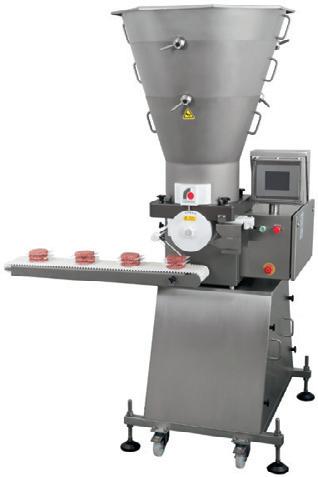


The unit shares the same look, maintenance-free housing and enhanced 360° LED visual status indication as the ThinkTop V-series control tops. Its compact, robust design makes it suitable for tight installations. Manufacturers select the communication protocol — digital, AS-Interface or IO-Link — that is best suited for their processing needs.
The product is hermetically sealed for good readings of the valve position and to prevent the risk of water, dust and other unauthorised access into the unit. Using the point-to-point IO-Link communication protocol allows the connection of sensors to automation systems. IO-Link also makes access to real-time data easier, improving diagnostics and simplifying configurability and control while supporting Industry 4.0.
Alfa Laval Pty Ltd

www.alfalaval.com.au


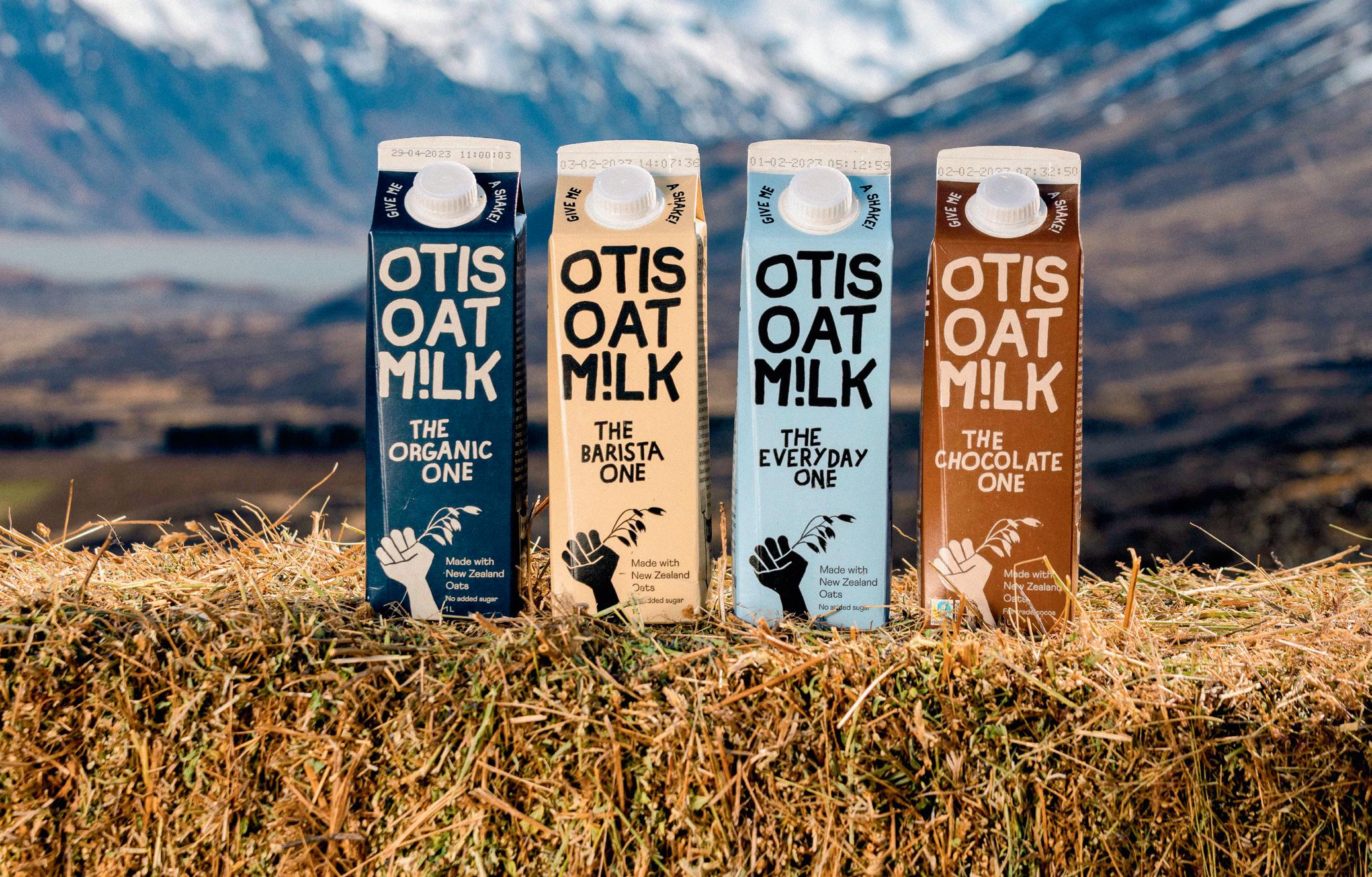
Ever since launching their company in Lincoln, Canterbury, in 2018, Otis co-founders Tim Ryan and Chris Wilkie have been on a mission to return to making their oat milk in New Zealand.

Due to a lack of a local factory with the technology required to produce oat milk to the company’s standards, Otis was shipping New Zealand oats to Sweden for manufacture.
“The journey to setting up our own factory has been long and hard and has involved seven feasibility studies over eight different sites across Aotearoa, costing a lot of money and years of graft for our small start-up,” Ryan said.
“We’re thrilled to have finally cracked this in a partnership with Auckland-based Free Flow, signing on as their first customer with Otis rolling off their lines from late 2023.”
The Free Flow manufacturing plant will be capable of making 50 million litres of plant-based beverages each year and is being developed with Sweden’s Angie Triantafyllou, known as the ‘godmother of modern oat milk’. With many patented innovations, Triantafyllou was a co-founder of Oatly and is now chairman of the board at Swedish plant-based technology company Cerealiq.
She said Otis was the first oat milk maker in New Zealand to use Cerealiq’s patented enzyme technology.
“The new facility will produce oat milk to the world-class standard levels of beta-glucan, the nutritional gold ingredient found in Otis and premium oat milks. It helps the body to maintain stable cholesterol levels,” Triantafyllou said.
Ryan said Free Flow and Cerealiq’s technology will be available to other plant-based beverage makers in New Zealand.
He and Wilkie started Otis Oat Milk with a strong underlying philosophy that food has the power to change the world.
The company works closely with the New Zealand Oat Industry Group, Harraways, as well as around 50 farmers who operate a crop rotation system to ensure the oats remain nutritional.
According to Ryan, plant-based milk alternatives have skyrocketed in recent years to outpace traditional dairy milk. In New Zealand, grocery spending on plant-based milk increased by 44% from 2019 to the end of 2022, with sales jumping from $61 million to $88 million.
“We’re beyond excited to return Otis’s manufacturing to its home in Aotearoa. It’s been a hard slog to find the right partner to make our world-class milk in New Zealand, but we’ve cracked it, and finally we can say Otis is 100% homegrown — from crop to cup,” Ryan said.
Johnson Screens New Generation Contra Shear (rotary drum screen) has been reengineered to provide operational cost savings through low-maintenance requirements, improved solids separation and dewatering.

Chain drives have been replaced with external rack and pinion drive mounted on the clean side, sealed-for-life bearings, and lubrication is not required anymore. Trommel wheels have been replaced with jockey wheels, which can now be changed over in situ in less than 20 min. Constructed from stainless steel, the rotary drum screen has virtually no wearing parts.
The new generation solid separation and dewatering has improved higher flow rates through the drum screens providing up to 30% reduction in BOD/COD, up to 25% reduction in SS and up to 15% reduction in TKN.
Options include CIP (cleanin-place), 304, 316, 2205 and 2507 stainless steel, electrical control panel, PLC Control Panel (Allen Bradley) and food-grade sealed-for-life bearings.
Johnson Screens
www.johnsonscreens.com.au
GEA Smart Filtration CIP and GEA Smart Filtration Flush, a software duo, automatically intervene in CIP (cleaning-in-place) processes, pulsing the pumps and flushing the membranes individually and according to real-time water quality.


GEA Smart Filtration Flush uses sensors to measure the permeate quality of the water during the flushing process, reducing the freshwater required. The software stops the process as soon as the necessary hygiene level is reached, and the cleaning agents are discharged. Depending on the type and size of the plant and the water properties, operators can reduce freshwater requirements by up to 50%.
The GEA Smart Filtration CIP regulates cleaning efficiency. It allows the pumps to operate in a pulsating manner as opposed to running continuously. As a result, the pumps are claimed to consume up to 50% less energy during the CIP process.

GEA Group www.geagroup.com.au
“Don’t

Common toolpath patterns used in additive manufacturing technologies: a) raster, b) zigzag, c) contour, and d) spiral. Credit: Ezgi Pulatsu and Chibuike Udenigwe
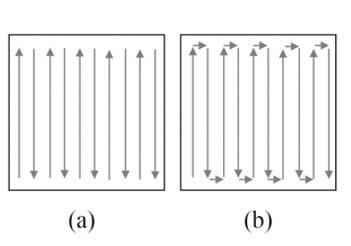
3D-printing food is on trend for creating novel food innovations but there are hurdles involved in adapting additive manufacturing to produce edible materials.
In Physics of Fluids, from AIP Publishing, University of Ottawa researchers Ezgi Pulatsu and Chibuike Udenigwe identify a range of factors that affect the print quality and shape complexity of food created with additive manufacturing. Accounting for these features can increase food quality, improve control and speed up printing.

Additive manufacturing technology relies on layer-by-layer operation to create an object that is pre-designed and coded with the help of specific software. Additive manufacturing of food involves designing (3D shapes and their geometric codes), pre-processing (food ink preparation), manufacturing (deposition of layers to create shapes) and post-processing (baking, boiling, cooking, freezing, frying or drying). Each step is an opportunity to create innovative foods.
Changing the printing patterns and ingredients of the initial mix or paste can affect the food’s matrix and microstructures and therefore its texture.
The flow of that mix in additive manufacturing is also crucial and is sometimes encouraged or discouraged by controlling ingredients and process conditions.
“Extrusion-based 3D printing is the most applicable technique for food,” Pulatsu said. “It involves a syringe loaded with a food paste — such as puree, dough, or frosting — being forced out of a nozzle by direct (pushing the plunger) or indirect force (compressed air).”
Creating a stable continuous flow is the first step to successful printing, so designed shapes can be produced by layering stringlike material in a controlled way.
“Once a layer is deposited, we no longer want it to flow; otherwise, it will destroy the shape we created,” Pulatsu said.
Post-processing — through baking, boiling, cooking, freezing, frying or drying — physically and chemically transforms the food’s micro- and macromolecules and leads to various textures and tastes. At the same time, the shape should be conserved or carefully controlled.
“We also have other mechanisms of creating food structures via different 3D-printing techniques,” Pulatsu said. “For example, material jetting uses liquid binders deposited on powder to form self-supporting layers, and liquid inks that harden after deposition can also be used.”
One way to make additive manufacturing more efficient for the food industry is by establishing a printing path (a series of computer-controlled movements), which is often skipped for food applications.
“Future studies should explore the cost efficiency of different technologies in terms of build time, where shape complexity and toolpath strategies — which involve the printing path, moving head speed and nonprinting movements — are also considered,” Pulatsu said.
“Food is essential to living, and it’s becoming more critical due to the increasing global population and environmental changes. Therefore, novel foods and matrices should be designed in consultation with chefs, food scientists and engineers, and in line with current needs.”












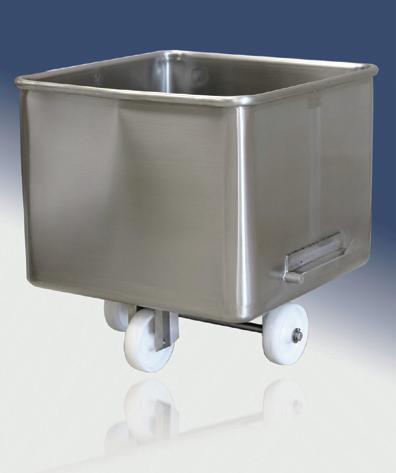



ELGi Equipments, together with authorised partner Compressed Air Controls, have provided an oil-free ‘Class 0’ turnkey compressed air system solution to a new food science facility jointly operated by a trio of New Zealand research providers.
The Te Ohu Rangahau Kai facility shared by Massey University, AgResearch and the Riddet Institute is situated on the university’s Manawatu campus in Palmerston North. The facility includes over 1800 m2 of research laboratory space that houses a range of hi-tech food science analytical equipment, including mass spectrometers which require high-purity nitrogen to analyse chemical molecules in food. Delivered by a nitrogen generator, the compressed air supply needed to be 100% oil-free and certified ‘Class 0’ in compliance with ISO 8573-1.
Massey University contacted its long-standing compressed air partner Compressed Air Controls, one of ELGi’s authorised partners, to find the right solution to meet the requirements.



Steve Carran, Compressed Air Controls Territory Manager, said, “We designed a complete skid-mounted turnkey solution, including an ELGi AB37 oil-free screw air compressor and an Airmate EGRD200 refrigerated air dryer complete with downstream filtration, and full stainless steel air lines to meet their needs.”
Keith Harvey, Massey University Project Manager, said it was essential that the nitrogen system’s air supply was certified Class 0. The AB series promised to meet those requirements with minimal environmental impact, aligning with the university’s sustainability goals.
“The recently installed ELGi turnkey compressed air solution, and Compressed Air Control's expert service and support is meeting our expectations,” Harvey said.


Installed in September 2022, the ELGi AB series was designed to meet AgResearch’s requirements for zero process contamination, low lifecycle and maintenance costs and low carbon footprint.

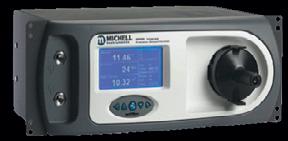
Ramesh Ponnuswami, Executive Director, ELGi OSEA, said, “ELGi’s AB series represents a real disruption in oilfree compressed air technology for sensitive industrial applications that not only demand 100% oil-free compressed air in compliance with ISO 8573-1, but want to achieve high reliability and high efficiency with low cost of ownership and minimal environmental impact. We are delighted to have supplied an AB series oil-free screw air compressor to this new food science facility, and to be a small part of the new Te Ohu Rangahai Kai building, one of the largest agricultural food research centres in New Zealand.”
Elgi Equipments Ltd www.elgi.com.au








Interworld Electronics is featuring the ViTAM-1 series of IP66/69K fully sealed stainless steel displays from APLEX Technology. The ViTAM-1 series is designed for a wide variety of industrial applications where sanitation is of serious concern, including food and beverage manufacturing. It offers increased protection by achieving IP66 and IP69K-certified protection with M12 connectors.

The 304 (or optional 316) fully sealed stainless steel chassis of the monitor makes it a suitable option for the food and beverage manufacturing industry due to its slim design and high corrosion and germ resistance, helping to prevent any bacterial contamination. It also makes the chassis easy to clean as it can withstand high-pressure cleaning, increases the life cycle of the chassis due to its rugged nature and helps to lower the cost of maintenance.



The product comes in a range of screen sizes (10.1″~24″ TFT-LCD) and resolutions (800x600~1920x1080). The optional PCT multi-touch screen with 7H anti-scratch surface helps to improve usability, while also providing the screen with tough protection. The optional high brightness, AR Coating and Anti-Glare, makes the series suitable for a range of applications, even when external environmental factors would normally cause problems.
With the following additional features: wide range 9~36 VDC power input, 0~50°C (optional -20~60°C) operating temperature, rear side OSD, ergonomic mounting options and flat front bezel design, the ViTAM-1 series is a suitable industrial display solution.
Interworld Electronics and Computer Industries www.ieci.com.au
Craig Mostyn Group is one of Australia’s leading diversified food and agribusiness companies. Established in 1923, Craig Mostyn Group is now claimed to be Western Australia’s largest vertically integrated pork, lamb and beef business. It also has seafood operations, which include three abalone farms and multiple sites across Tasmania. Its protein rendering unit, Talloman, is a core division of the Craig Mostyn Group, and when it started to have issues with a wastewater treatment pond, Plant Manager Carlos Mendes went looking for a solution.
The EchoStorm venturi aerator from Gorman-Rupp was recommended to him and he contacted Hydro Innovations (Australian Gorman-Rupp distributor) for a solution. Mendes wanted a reduction in BOD, COD and NH3, and also a solution to a troublesome blue-green algae issue.
Adding dissolved oxygen to aerobic bacteria allows organic compounds in wastewater to be broken down quickly, preventing it from becoming septic and odorous. The addition of dissolved oxygen allows these organic compounds to be converted into non-polluting compounds.
Based on the size of the pond, the inflow rate and water analysis provided, Hydro Innovations recommended a 4 ″ (100 mm) EchoStorm system. This system comprises a Gorman-Rupp U4B60S-B self-priming centrifugal pump with 15 kW motor, ‘powering’ a Gorman-Rupp V4A EchoStorm venturi aerator.
The EchoStorm is a static venturi aeration device that is installed on the discharge side of a Gorman-Rupp self-priming centrifugal pump to introduce dissolved oxygen into the liquid being pumped. With no moving parts, it only requires routine maintenance of the pump. The simplicity of the system makes it easy to install, operate and maintain.
The U4A60S-B is an efficient 4″ self-priming effluent pump, because of its multi-vane impeller and ‘straight-in’ suction design, making it suitable for keeping power consumption of the system low. It is also capable of passing a 20.6 mm solid, and operating on suction lifts up to 6.1 m.
The pump draws in water from the lagoon, then pumps it at pressure through the EchoStorm unit, which draws in atmospheric air, mixes it with the water and delivers it back to the lagoon. The unit not only ‘saturates’ the water with dissolved oxygen, but it also ‘conditions’ the flow, breaking down organic matter into smaller particles, allowing for enhanced organics reduction. This conditioning effect also ruptures the buoyancy vacuoles within the blue-green algae, causing it to sink, depriving it of the sunlight required for growth and stripping CO 2 from the water, depriving it of carbon dioxide.
Mendes and the Talloman evaluation team liked the idea of the equipment being mounted on the bank of the pond, rather than floating in the middle of it, and could see the ongoing benefits of easier access and the maintenance advantages of the system. As a safety-first company, they also saw the
system as being much safer for operators than other systems they had seen.
Mendes had his crew track the progress of the EchoStorm by measuring the total of all taxa from ‘Day 1’. When the unit was installed in March, total taxa measured 217,000. Mendes called off the measuring when the last reading was taken in May, where the measure was down to 6630 [a reduction of 97%]. Needless to say, Mendes and the Talloman team are happy with the results.
They have also been pleased at how easy the unit is to access for monitoring and maintaining.
The EchoStorm aerator units are available in sizes from 2″ (50 mm) through to 6″ (150 mm), but multiple units can be used to cater for larger requirements.
When the application calls for even high levels of oxygen, much larger (and even more efficient) pumps can be used, each providing flow to two, three, four or even five EchoStorm venturi aerators. The efficiency of these pumps drives up the standard oxygen transfer efficiency (SOTE) even further. The use of multiple EchoStorm units also enhances mixing and virtually eliminates dead spots that are often left by competing technologies.
EchoStorm units are versatile because they can draw water from any level in the water source and from any part, and can discharge it at any level, and any part. This gives the asset owner numerous options for mixing or creating different treatment zones.
Venturi aerators are not just used for treating food process wastewater, but are also used for treating municipal wastewater, mine water and also for lake destratification.

Hydro Innovations
www.hydroinnovations.com.au
Location and innovation have been revealed as key factors for shaping strategies for resilience and future growth in the UK craft beer sector, according to new research studies led by Northumbria University that investigated the impact the pandemic had on UK breweries.
In one study, published in academic journal Regional Studies, researchers identified how UK craft breweries adapted and responded to the pandemic crisis and explained how location shaped, and indeed is still shaping, breweries’ strategies in a ‘new normal’ world.

In a second study, published in International Journal of Entrepreneurial Behavior & Research , it was revealed that independent craft brewers were able to weather the pandemic by taking risks, embracing creativity and being innovative.

During the pandemic, urban breweries were found to be more effective in capturing support provided by the government and in adapting to changes required by lockdowns and restriction to movements, quickly moving packaging from casks and kegs to cans and bottles.
Overall, rural breweries felt the impact of crisis much more compared to breweries located in towns and cities, due to their demand being concentrated in reduced catchment areas and smaller networks supplying aid at a local level.

Research lead Professor Ignazio Cabras, from Northumbria University’s Newcastle Business School, said: “Being located in an urban or rural area made a difference for breweries during the height of the pandemic. Urban breweries reacted more promptly to the crisis and adapted to changes faster than rural breweries. While our research demonstrated the cruciality of financial support provided by the government to breweries during lockdowns and movement limitations, support by local people and other local businesses were equally significant factors in how craft brewers, in the absence of pubs being open to supply products to, survived the crisis.”
Professor of Rural Entrepreneurship at Northumbria Dr Gary Bosworth said: “What surprised us most was just how many strategies these brewers discovered to strengthen their resilience in the face of unprecedented challenges. We found that it wasn’t changing business strategy that put businesses on the right foot to move forward in the initial stages of the crisis, but individual attitudes to the pandemic — those who felt the crisis would pass were less likely to make investments during the period and slower to innovate.”
The second study found that individual resilience must come ahead of evolving company strategy, in order for small businesses to face the challenges of unexpected events, such as the pandemic.
Dr Ekaterina Shakina, Assistant Professor at Newcastle Business School, said: “COVID-19 changed perspectives for craft breweries. Before the crisis, for instance, craft breweries tended to brew
a much wider range of beers; however, now many refocused their efforts on core and flagship beers, cutting seasonal beers to achieve economies of scales. Compared to pre-COVID-19 times, much investment has been also redirected from capital infrastructure to marketing and social media, to maintain and keep up with the customers base acquired during the pandemic.”
The study highlighted examples of innovation in the craft brewing industry that could be adopted into the future, such as a craft brewing company that offered free same-day local delivery and collaborated with local beer venues for ‘tap takeovers’, giving something back to the places affected by COVID-19.
Ben Cleary, Founder of Full Circle Brew Co, based in Newcastle, said: “As a brand new startup we launched our first batch of beer right as the pandemic hit, which had its positives and negatives. We didn’t have well-established routes to market, so we were completely flexible and could adapt very quickly. We moved all of our production from keg to cans, set up a website within two weeks and launched FCBC Now — our free same-day local delivery service. Export became a lifeline to us — by October 2020, export made up 70% of our sales — until Brexit was implemented!
“Community engagement was also a key driver for us. In the early days of the pandemic, with many people furloughed and unable to go anywhere, we put on online tasting sessions. As restrictions eased, we teamed up with some of the best North East craft beer bars, to launch our Full Circle North East Revival Tour, hosting tap takeover events at their venues to bolster sales and providing some free kegs to each of the bars to encourage people to support local, and enjoy great beer.
“Supporting communities both locally and further afield remains as important to us as we move to a post-COVID economy. We’ve run initiatives to fund brewing qualifications to support women looking to work in the sector, created beer packs with a portion of the profits going to Women’s Street Watch Newcastle and collaborated with Medical Aid Ukraine Northeast and Ukrainian brewery Varvar to help get essential first-aid equipment across to Ukraine. Using the brewery as a force for good has helped us to establish our business through a really difficult time.”
This kind of collaborative working, along with making changes to packaging, increasing digital presence, making efficiencies and cost savings, as well as the willingness of local people to buy from small businesses, all meant that craft brewers who employed these methods were more successful than those who took fewer risks and decided to ‘wait for the storm to pass’.
Researchers said that further studies are needed to understand the full extent of how impactful individual resilience is to achieve whole company resilience, but it was a clear factor in how craft breweries progressed through the pandemic.


Better Juice has announced the successful completion of a series of pilot trials for reducing simple sugars in natural berry and other fruit juices. In partnership with GEA Group, Better Juice hosted several fruit juice manufacturers from the EU, the US, Australia and Brazil to give their brands a sugar-reduction makeover using its technology.
The trials were conducted at a pilot unit built last year in GEA’s innovation centre in Ahaus, Germany. Accommodating the GEA Better Juice Converter Skid, the site is equipped with continuous flow columns containing Better Juice’s sugarreducing beads. During the trials, sugar content across a range of forest fruit juices, including strawberry, cherry and blueberry, was reduced by 30–50% while preserving taste and texture.
Eran Blachinsky, co-founder and co-CEO of Better Juice, said forest fruit juices typically contain 10% or more sugar.
The company’s proprietary sugar-reduction beads are non-GMO microorganisms that naturally convert the juice’s sucrose, glucose and fructose into prebiotic oligosaccharides and other non-digestible fibres while retaining nutrients.
Gali Yarom, co-founder and co-CEO of Better Juice, said several companies expressed an interest in bringing the products they tested to market.
“We are currently in advanced discussions with several major US-based fruit juice companies to install our technology in their juice production systems. We project sugar-reduced forest fruit juices will reach the shelves early next year,” Yarom said.
The treatment process was claimed to be successful for clear NFC (not from concentrate) juices, dense concentrates and pulp-retained juices. Concentrates are used by a number of juice manufacturers to reduce shipping costs by evaporating the water and adding it back during bottling.



Forest fruit juices naturally contain pulp, and many juice companies aim to retain it in their products. Better Juice’s technology has been designed to ensure pulp remains in the product to preserve the nutritional benefits of the fruit.


Michael Harenkamp, Sales Support Engineer for NonAlcoholic Beverages, GEA, said companies also tested other fruit-based products, such as jams. Better Juice
www.better-juice.com

The coded safety switch PSENcode key only allows authorised persons to access machine functions and prevents the machine restarting. It is designed as an alternative to the more comprehensive solution with the pushbutton unit PITgatebox and integrated PITreader. A PSENcode key is the symbiosis of Pilz’s PITreader actuator and its non-contact safety switch PSENcode. It enables safe solutions up to PLe and SIL3.
Two applications are possible with the PSENcode key, thanks to its key lock principle. Firstly, if the employee has the key, he or she receives the machine enable that’s tailored to their individual task and can enable operating modes. Secondly, if the key is on the machine, the employee can remove the key, so preventing the machine from starting unintentionally.
The safety switch is used for position monitoring and monitoring the position of guards in accordance with EN 60947-5-3. It comes with integrated evaluation and standard interfaces and is thus open to products from other manufacturers. This makes the coded safety switch suitable for a user’s environment and an upgrade to a plant.



It can be combined with safety device diagnostics which are designed to avoid service callouts and reduce downtimes.


Features of the coded safety switch include: mode of operation: RFID transponder technology (nonmagnetic action principle); diagnostic interface: 3 LEDs; designs: narrow, compact or large; outputs: 2 safety outputs; inputs: 2 safety inputs; protection type: IP67/IPK69K; coding of PSENcode for safety gate monitoring: coded, fully coded, uniquely fully coded; and coding of PSENcode for position monitoring: coded.
Pilz Australia Industrial Automation LP www.pilz.com.au

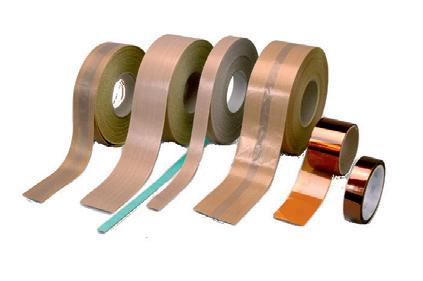

The GEA T.VIS E-20 control top is suitable for the dairy industry and other industries that process highly flammable hazardous substances in the form of milk powder and sugar dust.
The product uses LEDs with limited ignition energy to clearly indicate the active position, protecting it from explosion (Ex) hazards and making it compliant with global Ex certifications. It has a compact design with an installation height of 160 mm to facilitate installation and maintenance. Compared with its predecessors, its shock resistance has doubled to 10g. Internal spring-loaded terminals secure the electrical connections under heavy stress caused by vibrations.
Using T.VIS housing technology, all components feature dust and moisture protection according to IP6K9K. The internal pilot valves have also been converted to tappet technology to assist sealing performance.
GEA Group
www.geagroup.com.au
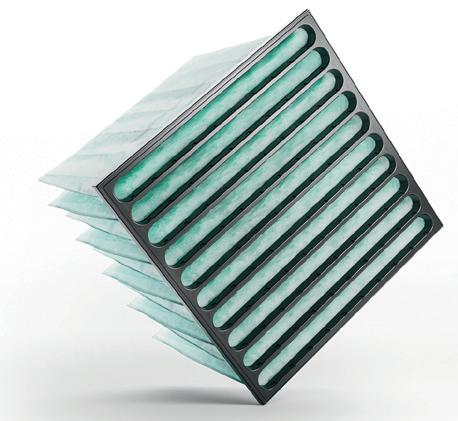
Camfil Hi-Flo bag filters are designed to suit commercial and industrial HVAC applications. They clean the air of particles and improve indoor air quality and workplace conditions.
The Hi-Flo bag filter series is focused around providing efficient and sustainable clean air solutions. The Next Generation range continues this legacy with a specific focus on improving the ePM1 60% and ePM10 60% range.
The bag filter offers a reduction in energy consumption of 12% when compared to the old Hi-Flo series products, and up to 30% lower energy consumption than the industry average.
When air flows as freely as possible through the pockets of an air filter, with low resistance, the filter will perform better. The Hi-Flo bag filter achieves this with conical pockets and a developed seam design and stitching technique, distributing air over the entire filter surface for maximum use of the filter media.
The Hi-Flo bag filter series is tested according to ISO 16890 and certified by Eurovent to ensure optimal filter and system performance.
Camfil Australia Pty Limited
www.camfil.com/en-au
NOSHOK announces the availability of its 20, 25 and 30 Series Intelligent Pressure and Level Transmitters, which are specifically designed to address the requirements of the food and beverage industry. The transmitters are suitable for hygienic applications and harsh, aggressive ambient conditions.

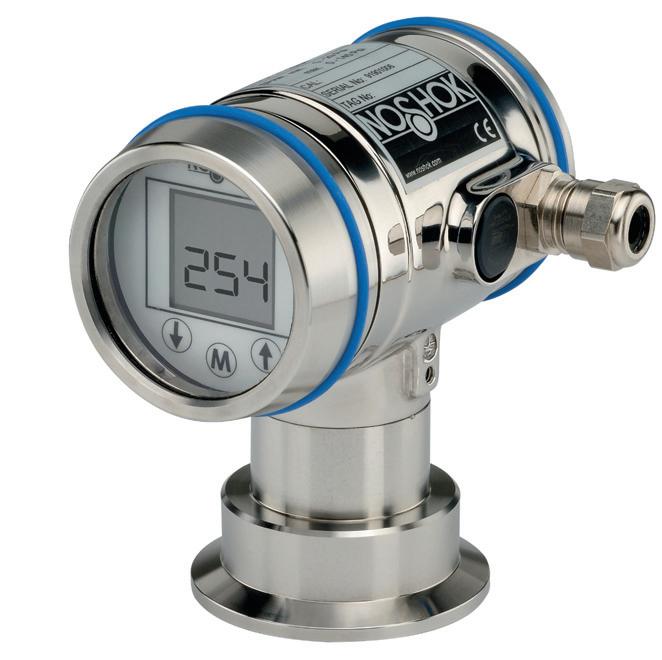
The series features a design that positions the pressure and temperature sensors directly behind the diaphragm, which minimises fill fluid and allows the use of a smaller diaphragm. This provides active temperature compensation at the point of measurement to minimise temperature and position error.
Turndown ratios up to 10:1 allow greater rangeability, minimising inventory requirements. Accuracies are based on percent of adjusted span, not full scale range.
Constructed of all polished stainless steel, NOSHOK’s intelligent transmitters feature programming via a standard onboard display with no pressure source required, and are also available with Hart protocol. The transmitters have a 360° rotatable display for flexibility and readability in multiple mounting positions.
The series is designed to meet 3A requirements.
AMS Instrumentation & Calibration Pty Ltd
www.ams-ic.com.au

The utilisation and valorisation of waste and co-products continues to be a top priority for many food manufacturers for both economic and environmental reasons, and meat processors are no different. Meat and poultry processing operations frequently produce a range of different by-products and leftover materials, many of which are turned into meat, blood and bone meals used as commodity products or as components in animal feed.
However, there is a growing awareness of the fact that much of this material is a rich source of high-value edible protein, with numerous potential products and uses. In recent years we have seen increasing demand for a range of solutions to help process bone, skimmings’ blood and blood plasma, fats and oils, gelatine, mechanically deboned meat (MDM) and edible protein components. These solutions range from individual heat exchanger components through preengineered to complete processing solutions. The common driver for these installations is to produce products with better quality, at lower cost and with less waste and lower energy consumption.
Heat exchangers may be used for a range of purposes, including heating, cooling, pasteurisation, sterilisation and even evaporation. Materials such as meat slurry, MDM, minced meat and viscera have a high fouling potential (which limits heat transfer), but also need delicate handling to preserve their integrity. To enable this, scraped surface
heat exchangers are usually the most suitable option when handling meat products.
In one installation, the HRS RHD Series, which uses a rotary scraping action, was used to help keep poultry trimmings and elements such as chicken necks, beaks, and feet below a specified temperature of 4 °C. The thick, viscous nature of the material means that a phenomenon known as ‘slugging’ can occur, where a channel of warmer product travels down the centre while the product at the tube wall does not move. As the cooling medium was below -5 °C, this created the risk that the product at the tube wall will freeze, while the material in the centre is not cooled sufficiently. Because the RHD Series ensures thorough mixing in the heat exchanger, this phenomenon does not occur.
To ensure efficient and reliable operation with these difficult products, HRS adapted the internal scraper configuration to achieve the high performance necessary, while implementing a heavy-duty gearbox to withstand the higher torques required to keep the product moving. A glycol cooling system reduced the temperature of the product from 23 °C to just 3.5 °C in a continuous pass, with a total retention time around 4 minutes. An autonomous control system ensured that any finished product which had not reached the required temperature was diverted back to the start of the process for further cooling.

For other situations, a reciprocating scraped surface heat exchanger, such as the HRS Unicus Series, may be more suitable.
The Unicus series is ideal for a wide range of difficult meat products and meat waste streams. Unicus heat exchangers are available with a wide range of scraper types, providing even more choice for applications from cooling to sterilising and everything in between.
The HRS Unicus series has proved particularly useful in handling viscous food products where texture and consistency are important attributes. For example, some meat mixtures may shear or break apart when subjected to too much pressure and speed, making them unusable. The Unicus means that effective heat transfer can be carried out at low pressure overcoming such problems. Some of the practical uses of the Unicus Series include cooling chicken viscera and pet food ingredients, cooling MDM and heat or cooling blood.
As well as heat exchangers, HRS produces a range of other products for handling very viscous materials, such as the BPSC Series of piston pumps which uses a gravity-fed hopper, together with a screw conveyor, to feed product into the inlet of the pump: an ideal partner for feeding the Unicus when installed together.


The sensation of smell, olfaction, has an important role in to play in the palatability and flavour of food. To gain a better understanding of olfaction, scientists at UC San Francisco (UCSF) have created a molecular-level, 3D picture of how an odour molecule activates a human odorant receptor, a crucial step in deciphering the sense of smell.
The findings, published in Nature , are set to reignite interest in the science of smell with implications for fragrances, food science and beyond. Olfactory (or odorant) receptors — proteins that bind odour molecules on the surface of olfactory cells — make up half of the largest, most diverse family of receptors in our bodies.
According to Aashish Manglik, MD, PhD, an associate professor of pharmaceutical chemistry and a senior author of the study, the goal is to map the interactions of thousands of scent molecules with hundreds of olfactory receptors, so that a chemist could design a molecule and predict what it would smell like.
“But we haven’t been able to make this map because, without a picture, we don’t know how odour molecules react with their corresponding odour receptors,” Manglik said.
Smell involves about 400 unique receptors. Each of the hundreds of thousands of scents we can detect is made of a mixture of different odour molecules. Each type of molecule may be detected by an array of receptors, creating a puzzle for the brain to solve each time the nose catches a whiff of something new.
“It’s like hitting keys on a piano to produce a chord,” said Hiroaki Matsunami, PhD, professor of molecular genetics and microbiology at Duke University and a close collaborator of Manglik. Matsunami’s work over the past two decades has
focused on decoding the sense of smell. “Seeing how an odorant receptor binds an odorant explains how this works at a fundamental level.”
To create that picture, Manglik’s lab used a type of imaging called cryo-electron microscopy (cryo-EM) that allows researchers to see atomic structure and study the molecular shapes of proteins. But before Manglik’s team could visualise the odorant receptor binding a scent molecule, they first needed to purify a sufficient quantity of the receptor protein.
Odorant receptors are notoriously challenging, some say impossible, to make in the lab for such purposes.
The Manglik and Matsunami teams looked for an odorant receptor that was abundant in both the body and the nose, thinking it might be easier to make artificially, and one that also could detect water-soluble odorants. They settled on a receptor called OR51E2, which is known to respond to propionate — a molecule that contributes to the pungent smell of Swiss cheese.
But even OR51E2 proved hard to make in the lab. Typical cryo-EM experiments require a milligram of protein to produce atomic-level images, but co-first author Christian Billesbøelle, PhD, a senior scientist in the Manglik Lab, developed approaches to use only 1/100th of a milligram of OR51E2, putting the snapshot of receptor and odorant within reach.
“We made this happen by overcoming several technical impasses that have stifled the field for a long time,” Billesbøelle said. “Doing that allowed us to catch the first glimpse of an odorant connecting with a human odorant receptor at the very moment a scent is detected.”
This molecular snapshot showed that propionate sticks tightly to OR51E2 thanks to a very specific fit between odor-
ant and receptor. The finding jibes with one of the duties of the olfactory system as a sentinel for danger.
While propionate contributes to the rich, nutty aroma of Swiss cheese, on its own, its scent is much less appetising.
“This receptor is laser focused on trying to sense propionate and may have evolved to help detect when food has gone bad,” Manglik said. Receptors for pleasing smells like menthol or caraway might instead interact more loosely with odorants, he speculated.



Along with employing a large number of receptors at a time, another interesting quality of the sense of smell is our ability to detect tiny amounts of odours that can come and go. To investigate how propionate activates this receptor, the collaboration enlisted quantitative biologist Nagarajan Vaidehi, PhD, at City of Hope, who used physics-based methods to simulate and make movies of how OR51E2 is turned on by propionate.
“We performed computer simulations to understand how propionate causes a shape change in the receptor at an atomic level,” Vaidehi said. “These shape changes play a critical role in how the odorant receptor initiates the cell signalling process leading to our sense of smell.”
Manglik envisions a future where novel smells can be designed based on an understanding of how a chemical’s shape leads to a perceptual experience, not unlike how pharmaceutical chemists today design drugs based on the atomic shapes of disease-causing proteins.
“We’ve dreamed of tackling this problem for years,” he said. “We now have our first toehold, the first glimpse of how the molecules of smell bind to our odorant receptors. For us, this is just the beginning.”
BOGE has expanded the fourth generation of the S series, which now covers the entire 45 to 150 kW performance range. All models are characterised by quiet operations and good efficiency values. The compressors generate high free air delivery at low specific power consumption. The energy use of the new 75 kW compressor has been reduced by over 12% compared with its predecessor, while the free air delivery has increased by almost 9%. The generously sized components reduce internal pressure losses, and with a footprint of just 1.20 x 2.00 m, the housing of the new models is smaller than older models. The compressors come with the high-performance, low-energy IE4 motors and permanent magnet motors fitted as the industry standard.

The vertical oil separation concept contributes to low residual oil content, minimal pressure losses and a long service life, while the internal cartridge is quick and easy to remove and replace. Maintenance takes place from two sides with just a few simple movements — the intake filter is accessible and both the oil and air coolers can easily be removed and cleaned.
Boge Compressors Ltd
www.boge.net.au
CleanAire II Ductless Hoods are designed to meet DH I requirements as defined by SEFA 9. The hood features a built-in carbon filtration system to adsorb non-toxic fumes and odours. It is equipped with an integral blower, vapour-proof light, fan and light switches.
The hood is constructed of chemical- and flame-resistant, non-metallic, composite resin with a moulded one-piece seamless interior fume chamber. A vertical sliding, clear acrylic sash is designed to protect the user, and it contains the process fumes.


The included carbon filter adsorbs the fumes and then recirculates the air back to the laboratory. The hood is shipped assembled and ready for operation.
HEMCO Corporation
www.hemcocorp.com

Motivated by a need to help food regulatory authorities with detection of adulterated food products (products where certain ingredients are missing or replaced), University of Missouri scientist Colleen Ray and colleagues in the Department of Chemistry are now taking on the role of ‘food detective’ using their novel detection method.
The method uses nuclear magnetic resonance (NMR) spectroscopy to detect whether food products have been modified or adulterated with fillers like vegetable oil.
NMR spectroscopy uses a magnet and radio waves to determine the content and purity of different substances and has been used before with other food products like honey, olive oil and wine, according to C Michael Greenlief, Director of the MU Proteomics Center and Nuclear Magnetic Resonance Facility and corresponding author on the study.
“The analysis of food products with NMR spectroscopy is a powerful tool for the detection of adulteration,” said Greenlief, who is also a professor of chemistry. “It is ideal for analyses of this type due to a high sample throughout, the ability to discriminate based on structural differences of metabolites with similar masses and the ability to examine samples in either their native state or with little sample preparation.”
The scientists have created and tested a method to identify vegetable oil adulterants in hard cheese products. They discovered 29% of 52 samples of various non-refrigerated grated parmesan cheese were adulterated with palm oil, an ingredient that was not declared on the product labels.

“Genuine cheeses were found to have a very consistent lipid profile from sample to sample, improving the power of this approach to detect vegetable oil adulteration,” Ray said. “Palm oil itself is a clever adulterant owing to its semi-solid state at room temperature, similar colour to cheese and low price compared to cheese. However, this study is strictly limited to the lipid profile of these products, and no attempts were made to quantify any fillers aside from palm oil.”
The study, Detection of vegetable oil adulteration in pregrated bovine hard cheeses via 1H NMR spectroscopy, has been published in the journal Molecules University of Missouri https://missouri.edu/
Interworld Electronics has introduced the FABS-9A series of foodgrade stainless steel panel PCs from APLEX Technology.


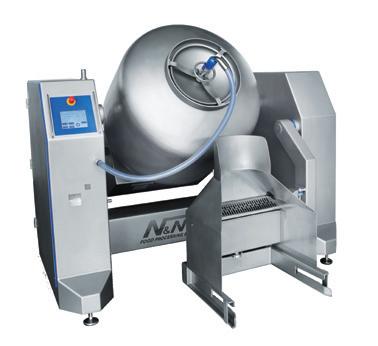






The FABS-9A series is housed in a fanless aluminium enclosure with a 304 or optional 316 grade stainless steel bezel that provides IP66/IP69K front panel water and dust protection. The series has been designed to meet the hygienic design requirements of DIN EN 1672-2.
The PC series is powered by an Intel 6th generation Core i3/i5 processor with DDR4 memory. The series comes in a range of sizes, 12.1 ″ to 21.5″, all with a 7H anti-scratch surface and projected capacitive or resistive touch screen options with optional high brightness, making them suitable for a range of applications and environments, including outdoor.
It includes 2 x COM, 2 x GbE LAN ports and 2 x USB3.0 ports as well as support for internal Mini-PCIe expansion modules. Communication and network options include 3G/4G, WiFi/BT, GPS and RFID.
The FABS-9A supports DC 9–36V power input and an operating temperature range of 0–50°C. Operating system support includes Windows 10 and IoT.
The PC is 58 mm deep, making it suitable for applications with limited room. Support for both Panel and VESA mounting makes the FABS Series convenient to install.

Interworld Electronics and Computer Industries
www.ieci.com.au

Arla Foods Kruså achieves both environmental and financial savings by replacing its microfiltration system with a UV system from Lyras. Waste and energy consumption is reduced, while cleaning and operation has also become simpler and cheaper.
The Lyras UV system is being used to treat all brine for the company’s production of salad cheese. It allows the cheese plant to reuse 100% of its brine so it can eliminate the CO2 emitted from the salt retentate disposal. Previously, using microfiltration, 10–12% of the salt was disposed as retentate.
Cleaning has also become easier as the plant can run CIP from its central systems, which now only takes 15 minutes.

Adding to the environmental profits is reduced energy and water consumption, as well as 10% less salt usage, said Packaging Manager Vagn Clausen (pictured) from Arla Foods Kruså.
Werner
Fischbach is also pleased with the new technology. “It is much easier to operate the new UV system compared to the microfiltration plant. We control the raslysation unit from our SCADA system, just as we do with the rest of our process equipment. The Lyras system worked from day one.”
Each time one of the dairy’s brine tanks with salad cheese cubes is emptied after one to two days of salting, the cheese has the right percentage of salt for use in cups and glasses with added chili, tomato, paprika and oil. Brine from emptied tanks is reused but is treated between each new production to avoid unwanted yeast growth.
Previously the plant used to microfiltrate the brine. As the production and demand for salad cheese is increasing, the dairy was looking for a plant able to process larger amounts of brine per hour while achieving the same microbiology as from the microfiltration plant.
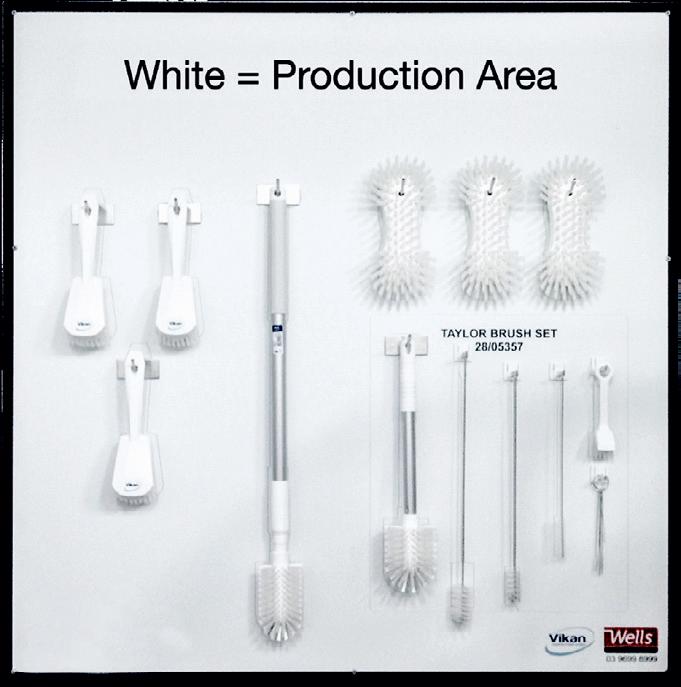
With 43 years of experience in the business, Clausen was not afraid to take a closer look at Lyras’ technology. It is designed to ensure good food quality even in opaque liquids by way of UV light eliminating bacteria and spores.

“It is good to have a recent technology challenge the existing. Recent technology, such as raslysation, could well be the future in some areas, as the technology is incredibly simple. It makes our job easier and helps protect the environment.” Clausen said.
Lyras A/S lyras.com
The MicroFlow I Workstation is a ductless carbon filtered workstation equipped with activated carbon filtration, designed to collect small amounts of non-hazardous fumes and odours.
It is completely self-contained with an integral recessed work surface to contain spills, with a clear hood surround with safety viewing sash for user. The sash can be conformed for use with a microscope. Variable speed fan control provides the option of high and medium speeds, or low flow for sensitive operations.

It operates on 115 VAC or 230 V international and conforms to UL, CSA and CE requirements. The electrical cord port exits on the left side. Used filters are easy to change, recommended every 60–90 days. The filter life varies with usage.
HEMCO Corporation
www.hemcocorp.com
smartLink SW-HT is a Docker container-based software application. It allows access to HART devices connected to remote I/Os that can be reached via Ethernet. No additional hardware is required for this. It has enabled the use of remote I/Os from Allen-Bradley, Schneider Electric and R. Stahl. The version 1.30 also supports ET200 remote IOs from Siemens and the FDT DTM interface. Configuration and diagnostic data are accessed via Emerson’s AMS Device Manager or other HART IPenabled Plant Asset Management applications. smartLink SW-HT provides an Ethernet connection for tunnelling the HART commands to the remote IOs.

Softing Industrial Automation GmbH
www.industrial.softing.com

excess pressure for a 500 mL bottle times the production rate equates to 1.5 m3/min in artificial demand.

Measurement and recording of actual pressure flow inside the production equipment can assess the actual performance of the compressed air system. This identifies any areas where compressed air problems are causing limitations on productivity and quality of production, the improvement of which in turn can lead to lower energy use costs and increased production rates.
All blow moulding processes require stable compressed air pressure delivered to the moulding machine to control quality and maintain productivity. In most blow moulding processes, compressed air is used to inflate the parison, a tube-like piece of plastic with a hole in one end through which compressed air can pass. The compressed air also cools the part after inflation to final form, but prior to ejection from the mould.
In PET bottle blowing, high-speed machines use compressed air to produce bottles at rates of over 20,000 bottles per hour. The rate of pressure rise becomes dependent upon the pressure differential driving the flow from the air inlet of the machine to the cavity. The higher the inlet pressure the faster the rate of pressure rise.
Increasing the system pressure is a common way to maximise productivity and still produce good product. Unfortunately, higher pressure leads to wasteful artificial demand, elevated compressor energy and maintenance costs, and inefficiency in managing the system.
Blowing the part as quickly as possible leads to very high rates of flow in supply components creating high pressure drop. A blow machine running 24,000, 500 mL bottles per hour can consume 90 m3/min depending upon setup creating significant pressure drop in the headers and filters delivering the air. In order to make acceptable bottles with this level of pressure drop the system has to operate at dramatically higher than necessary pressure.
This higher than necessary pressure means each bottle requires a greater volume of air, and because the header pressure is elevated to increase the inflation pressure differential, the blow pressure continues to rise to higher than required pressure after the bottle is fully moulded. For every bar of pressure increase above the required blow pressure, the volumetric flow required increases by the volume of the bottle. For example, one bar in
The most common compressor for achieving these pressures is a 3-stage reciprocating machine which uses valves to control the flow of air through the stages. At these higher pressures the temperatures are higher, increasing the stress and wear on critical components. Where it was possible to substantially decrease the discharge pressures, maintenance cycles are extended by as much as 25–30%. Power is also reduced at the lower discharge pressures by a ratio of 1% energy reduction for every 5% pressure reduction. A reduction of 700 kPa or 16% will mean about a 3% energy reduction at the compressors.
The first step in capturing efficiency opportunities is to minimise the pressure drop within the moulding machines, which normally requires removing and/or replacing pneumatic components with those of higher flow capability. The regulators and filters are critical items and must be examined closely by measuring the pressure drop while the machine is blowing bottles. Localised storage receivers can minimise pressure drop by supporting the very high rates of flow during each blow cycle with stored air. This storage must be located as close to the point of consumption as possible; for example, it must be tied into the pneumatic circuit after the filter and regulator to be of any value.
Managing this level of pressure change requires significant modifications in the approach to system management. While compressed air storage tanks can be expensive, maximising the storage is essential with most compressed air systems as the lack of appropriate storage is even more costly if additional compressors are required to run part loaded to deal with the rates of pressure change.
An appropriate automation system which calculates the rate of pressure change and makes intelligent decisions regarding the appropriate supply-side response can make a significant difference in energy costs and reduce compressor cycling, wear and motor starts. Avoiding unnecessary compressor starts due to the rate of change can mean saving many thousands of dollars in energy costs per year.
Kaishan Compressors offers an assessment and advisory service for upgrading, replacement, design and installation of new systems to match production demands.
Kaishan Australia Pty Ltd www.kaishan.com.auCompressed air is critical to blow moulding production and the opportunities to improve supply side efficiency are highly prevalent.
TorqSense SGR 510/520 torque sensors cover capacities from 0.2 to 1 Nm, making the full range 0.2 to 13,000 Nm. The bigger units are designed for use in machine tools, production and processing plant, heavy duty pumps and similar large-scale installations.
Based on a full four-element strain gauge bridge design, the SGR sensors have the ability to measure and record sudden spikes in torque load.

The sensor measures the torque 4000 times per second and uses high performance signal conditioning to provide a high bandwidth monitoring solution. This is further enhanced by 250% overrange and 400% overload capabilities, elimination of side and end load errors and real-time temperature compensation.
The non-contact signal transmission means the sensor exerts no load on the shaft it is monitoring, while maintenanceheavy slip rings have been designed out.
Three analog output channels on the 511 mean the SGR can measure real-time speed and power alongside the torque monitoring. A third output is dedicated to self-diagnostics and/or status functions. An Ethernet gateway module can also be fitted to the unit.
As well as analog outputs, TorqSense SGR 520/521 is also fitted with digital outputs for interfacing with instrumentation and laptops. Options include RS232, CANbus and USB. A digital input is provided so that the 520/521 can be set up directly from a PC running specialist configuration software such as Sensor Technology’s TorqView or LabView.
Sensor Technology Ltd
www.sensors.co.uk
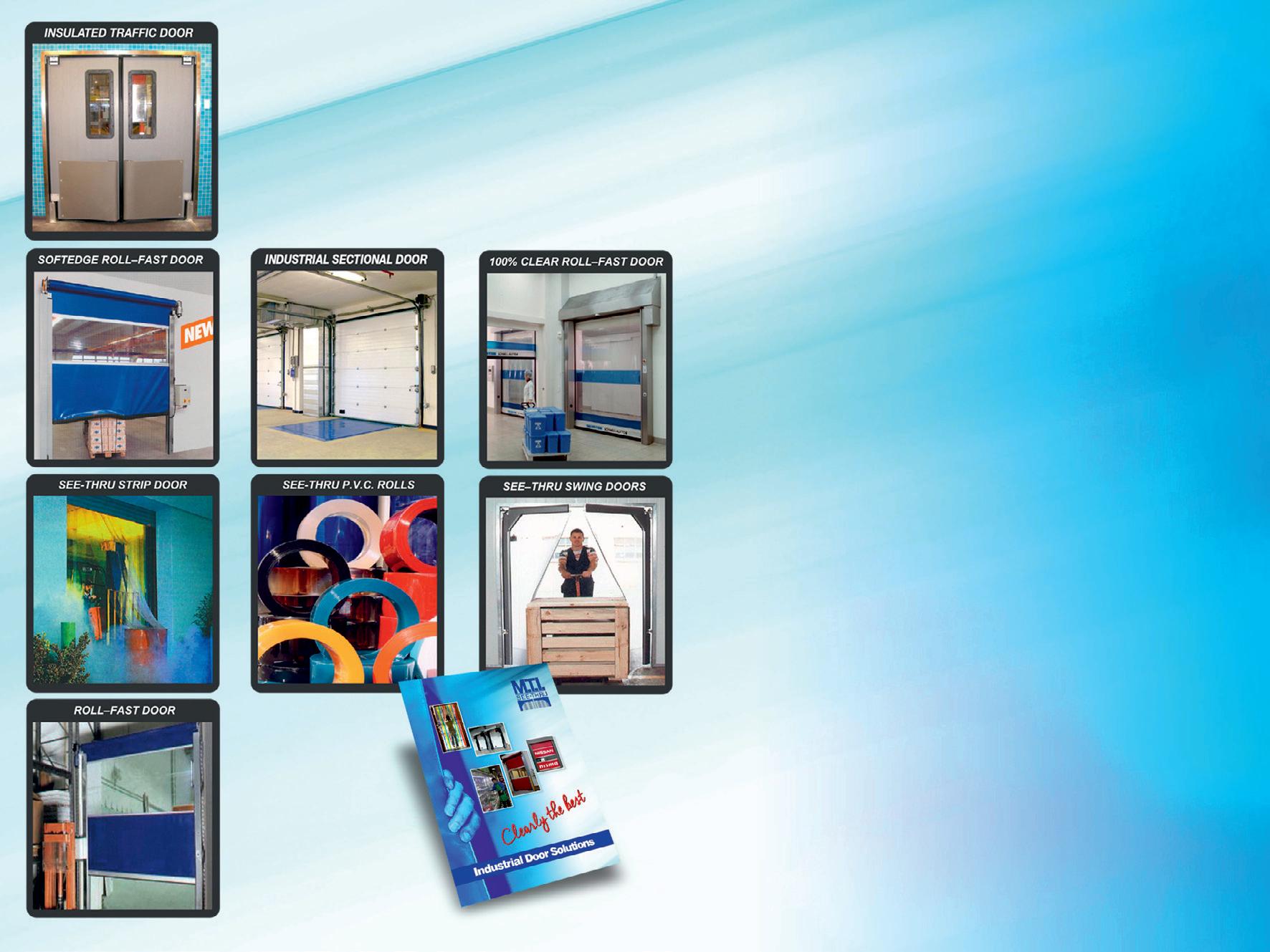
The Association for the Cannabinoid Industry’s (ACI) novel foods applications (RP126 and RP127) have been validated by the Food Standards Agency (FSA) in the UK.

The ACI received formal notification from the FSA that both its applications for the authorisation of CBD isolate and distillate ‘fall within the scope of the novel foods regime’ as set out in Regulation (EU) 2015/2283 (as retained) and fulfil the requirements set out in Article 10(2) of that Regulation.
These applications are now regarded as valid, and will now move on to the risk assessment stage to be assessed further.
ACI member applications account for 30% of the products currently permitted to remain on the market under the novel foods authorisation process.
These applications relate to 320 brands on sale in Britain.
In 2022, the ACI submitted a complete toxicological package and related bioavailability data to the FSA to support the consortium of member applications.
This included the dose range finding study and the OECD408 rodent toxicity study to determine a No Observable Adverse Effect Level (NOAEL), to cover the safety implications of not only CBD, but also the minor cannabinoids and other plant matrices present in these plant-derived products.
Two years on from the novel food application submission deadline, this week’s FSA update comes a year after the food safety body published its first public list of ingestible CBD products deemed temporarily compliant, pending the submission of toxicology data, its risk assessment and acceptance to progress to the validation stage.
Steve Moore, ACI co-founder and strategic counsel, said: “This is a key milestone for the sector and the ACI. The new consumer cannabinoid sector has been set as an important regulatory challenge. Today’s outcome suggests that by collaborating, they are both progressing towards market authorisation for thousands of products but also delivering the safety data the authorities have been crying out for.”
In 2019, the British FSA assigned ingestible CBD products with novel food classification under the Novel Food Directive. For a product to be legally available for sale, it must be present on the FSA’s public register, which is updated when the status of an application changes. Ingestible CBD products include CBD oil drops, tinctures and infused food or beverage. The directive does not apply to CBD vape products, cosmetics or topicals.
Siegfried Waldvogel and a team of researchers at the University of Mainz, Germany have developed a green method for recovering the flavouring agent vanillin from a by-product in the papermaking processes.
Around 20,000 tons of vanillin are used every year so it’s in high demand for not only vanilla flavouring but also in chocolates, perfumes and as a precursor material for pharmaceuticals. As the vanilla plant alone cannot keep up with this demand, researchers have now discovered a method for producing vanillin from Kraft lignin — the results have been reported in the journal Angewandte Chemie

Lignin and cellulose are essential components of wood. The molecular structure of lignin contains the structure of vanillin, the main flavouring substance from the vanilla plant, meaning that vanillin can be produced from lignin, although the process is laborious.
In order to make paper from wood fibres, all lignin has to be removed, otherwise the paper will take on the brown colour of the lignin.
At present, lignosulfonate, a substance that also forms in some papermaking methods, is used for the industrial production of vanillin. However, the waste product in the most commonly used pulping method for industrial papermaking, the Kraft method, is not lignosulfonate but rather a technical lignin referred to as Kraft lignin.
Kraft lignin is much harder to oxidise and depolymerise than other lignins and so at present cannot be used as a raw material. Instead, it is usually simply burnt as fuel for papermaking processes.
The researchers’ method for producing vanillin from Kraft lignin is claimed to be environmentally friendly as it doesn’t use any harmful chemicals, and it is convenient as it uses the raw materials present in pulp production. A key step in this new method is the production of the oxidiser by electrolysis of sodium carbonate.
The team reported that, when freshly produced, the peroxodicarbonate depolymerises and oxidises Kraft lignin with similar effectiveness to traditional methods. However, in a departure from these conventional methods, no harmful chemicals are used or produced in the process.
Neogen provides food and environmental allergen testing solutions to meet specific food safety requirements. Its local presence has been expanded through its recent merger with 3M, a leader in food safety testing. The merger brings an extended range of food and environmental allergen testing products, including LFDs, ELISA and allergen protein swabs.
Neogen’s expanded range of lateral flow tests can deliver rapid results in 5 min, while qualitative results with ELISAs take 30 min.
The company has over 50 options in the allergen category, with products that screen for allergens in various sample types, including environmental swabs, CIP rinses and validated food matrices.

Neogen complies with regulatory standards set forth by AOAC and NATA to support the Australian food safety sector. This enables labs and manufacturers to test and comply with FSANZ standards.

Neogen
www.neogen.com



Bestech Australia offers the complete range of kilolab reactors from PIGNAT ranging from 5 up to 50 L. The reactor range is designed for research laboratories or R&D centres as a scale-up tool in their development process.
The design of the reactor is flexible to meet the needs of users. Therefore, it can be tailored to suit different processes and mimic the real industrial environment as per requirement. The reactor can be easily installed in the laboratory and is robust, easy to run and easy to maintain.


Generally, the reactor can be used for the synthesis and hetero-azeotropic distillations. These reactors facilitate process development by their specific design and the different technology that is integrated in them. These are adaptable units designed to include glassware set-ups for batch reactions, distillation set-ups and chemical synthesis in kilo laboratories and pilot plant systems. Its glass construction allows it to display various physical phenomena. Furthermore, the mobile tanks facilitate portability and safe handling during the feeding and draining operations.
With its partner PIGNAT, Bestech Australia designed the unit to give as much flexibility to manage a dynamic process portfolio while fulfilling environmental, health and safety, product quality and business goals.
Bestech Australia Pty Ltd
www.bestech.com.au
Arla Foods Ingredients Peptigen IF-3080 protein hydrolysates for infant formula has received final EU approval. The product has been deemed safe and suitable for use in formulas and follow-on formulas in the EU.

Now the product has been included in the Commission Delegated Regulation (EU) 2016/7 — the final step necessary for it to be sold across the EU.
Arla Foods Ingredients
www.arlafoodsingredients.com
Mettler Toledo’s Easy VIS analyses liquid, translucent samples for their optical spectrum, colour and water parameters. The compact instrument is designed to take over the measuring tasks of a colorimeter, a spectrophotometer and water testing methods such as titration.


A typical place for product is the QC lab at small manufacturers in the food and beverage industry, environmental testing labs or any industry needing quality control and supervising their process or wastewaters.

It may be used during multiple steps of the production process, including the inspection of raw materials, quality control of semi-finished and finished products and testing the water quality of wastewater.



It contains a visual user interface with workflow guidance and operates within a wavelength range of 330 to 1000 nm. Its light source is a tungsten lamp that can be easily replaced when needed.
The instrument comes with 25 pre-installed standard-compliant colour scales such as ICUMSA for sugar colour, ESBC for beer quality analysis and OIL CIELab for wine colour determination. For spectrophotometry, the sample is analysed at the wavelengths where the sample has its absorption of light. It measures the transmitted or absorbed light and reveals the sample’s concentration or purity.
In the testing procedure, one cuvette holds the blank measurement and another is prepared with the sample. After the analysis method is chosen, the cuvette is placed in the cuvette holder and the PathDetect function recognises which path length is measured. The measurement begins when the lid is closed and results show up on the screen. The EasyDirect software allows for results to be saved automatically or exported to an external storage device or data management system.
Mettler-Toledo Ltd
www.mt.com




Researchers from Tufts University have bulk-produced fat tissue with a similar texture and make-up to fat tissue that naturally occurs in animals. The study, published in eLife , says the fat tissue could be applied to the production of cultivated meat, giving it a more realistic texture and flavour.
Cultivated meat is still in relatively early stages of development, with many startups yet to bulk produce or gain commercial approval of their products. Most of the products being developed are in the form of an unstructured mixture of cells, lacking the real texture of a fillet or steak, which is naturally created by muscle fibres, connective tissue and fat. For example, cell-grown chicken would be more similar to the texture of chicken nuggets than a slice of chicken breast.
Fat contributes texture and taste to meat, with tests showing that consumers prefer beef containing a higher fat content.
It has been challenging to produce cultured fat tissue in sufficient quantities because the cells in the middle become starved of oxygen and nutrients as the fat grows into a mass. In nature, oxygen and nutrients are delivered through blood vessels and capillaries — something which researchers have no way to replicate at large scale in lab-grown tissue.
The researchers grew fat cells derived from mice and pigs to get around the limitation, first growing them in a
flat, two-dimensional layer before harvesting those cells and aggregating them into a three-dimensional mass. The mass used binders such as alginate developed from seaweed and microbial transglutaminase (MTG), both of which are already used in some commercial foods.
The researchers’ goal was to develop a method that is relatively simple.
“Since fat tissue is predominantly cells with few other structural components, we thought that aggregating the cells after growth would be sufficient to reproduce the taste, nutrition and texture profile of natural animal fat,” said John Yuen Jr, a graduate student at Tufts University. “This can work when creating the tissue solely for food, since there’s no requirement to keep the cells alive once we gather the fat in bulk.”
The fat cells had the appearance of fat tissue, but the researchers carried out further tests to see if they reproduced the features of native fat from animals.
To explore the texture, they compressed the fat tissue and saw how much pressure it could withstand compared to natural animal fat. They found that fat bound with alginate withstood a similar amount of pressure to fat tissue in livestock and poultry while fat bound with MTG behaved more like rendered fat, similar to lard or tallow. This suggests that it may be possible to fine-tune the texture of cultured fat using different types and amounts of binders to make it as close as possible to natural fat.
It is also important to consider the molecular composition of fat. Cooking releases compounds that add flavour and aroma to the meat, most of which originate from fat, including lipids and component fatty acids.
The research team examined the composition of the molecules from cell-grown fat and found that a mix of fatty acids from cultured mouse fat differed to native mouse fat, but cultured pig fat had a closer acid profile to the native tissue. This suggests that it might be possible to supplement growing fat cells with different lipids for a closer match to the fatty acid composition of natural meat.
According to David Kaplan, professor at Tufts and director of TUCCA, this method may be translated to large-scale production of cultured fat tissue and bioreactors.
“We continue to look at every aspect of cultured meat production with an eye toward enabling mass production of meat that looks, tastes and feels like the real thing,” Kaplan said.

A packaging leak test is conducted in the production line as a final quality control stage to check the integrity of the seal. Industrial water bath leak tester has been widely used due to their simplicity. It involves submerging the packages underwater and determining the location of leaks by observing the formation of bubbles. The sample has to be disposed of after each test as the test method stress and destroys the packages.
Underwater leak tester is effective in locating leaks in packaging, but they produce additional production waste. There are alternative costeffective technologies for package leak testing that do not stress and destroy the package such as a pressure decay leak tester.
Bestech Australia supplies non-destructive package leak testers for testing the seal integrity of food and pharmaceutical packaging. The Sealtick 6086b operates based on the vacuum decay principle to test for defects in packaging. We have upgraded all our Sealtick machines with the new touch-screen HMI for ease of use and accessibility.
Our Sealtick machines have been used for seal quality checking in food manufacturing companies. For example, they manufacture dried goods with limited shelf-life such as milk powders, biscuits, potato chips, etc. Therefore, package leak testing is conducted during quality control to ensure their products can last in the supermarket.

Sealtick machines offer a reliable, accurate reading of leak rate due to their design. The testing chamber minimizes the airflow surrounding the package to achieve the highest reading sensitivity. As food packaging comes in various sizes and shapes, Sealtick leak testers are also available with different models to test a wide range of packaging from trays, flexible packaging, small packaging, tins and cans.
Manufacturers can benefit from significant cost-saving by incorporating a vacuum decay leak tester instead of a water bath leak tester in the manufacturing line. The supposedly discarded packages can be returned to the packing line if they do not leak. This means that significant waste can be avoided, which positively impacts the company, environmentally and financially.
However, Sealtick vacuum leak testers can also be used together with water bath leak testers. Often, operators need to perform maintenance on the sealing equipment if leaks are detected in the packaging. Operators can test the leaking package with the water bath tester to locate the leak locations, and determining the faulty equipment.
Sealtick leak testing machines are assembled locally in Australia in our manufacturing facility in Melbourne. Our team consists of engineers and experts with extensive industrial experience in testing and measurement. Contact Bestech Australia to discuss your package leak testing needs.

Arla Foods Ingredients Nutrilac ProteinBoost is a line of whey proteins based on patented microparticulation technology.
Rich in all nine essential amino acids, the ingredients in the range represent a complete protein source. Additionally, they are easy to add to food and beverage products and provide good texture and mild dairy taste.
They are suitable for use in high-protein ice cream, drinking yoghurts, high-protein dairy bites and spoonable yoghurts.

Arla Foods Ingredients
www.arlafoodsingredients.com

GNT has expanded its range of EU organic-certified EXBERRY Coloring Foods with yellow and green shades made from organic safflower.
EXBERRY Organics ‘Fruit & Veg Yellow’ is made from organic safflower and organic apple, while EXBERRY Organics ‘Veg Green’ is made from organic safflower and organic spirulina. Both are compliant with Organic Regulation (EU) 2018/848.
Suitable for a wide variety of food and beverage applications, the products extend the Organics range that already features red, purple, blue and orange options.
Based on the principle of colouring food with food, the range is created from edible fruit, vegetables and plants using traditional physical processing methods. They are certified organic in accordance with EU regulations and qualify for completely clean and clear label declarations throughout much of the world.
EXBERRY Organics concentrates are also 100% vegan-friendly, halal and kosher. In addition, the fully traceable raw materials are grown using sustainable methods by farmers working as part of GNT’s vertically integrated supply chain.
EXBERRY
www.exberry.com
The vented-hood tabletop workstation model 24200 is suitable for applications such as histology, microprocessor, venting for hot plates, microscope stations, sample weighing stations and handling pharmaceuticals.

Constructed of chemical-resistant, lightweight composites, it can be easily moved as procedures or workflow change.
Dimensions are 24 ″ wide x 15″ deep x 24″ high. The moulded chemical-resistant work surface is recessed to contain spillage and a 3 ″ diameter outlet collar is provided for duct connection.
The unit’s base consists of a recessed work surface to contain spillage. Fumes are vented through the integral fume side and rear walls and out the top.
HEMCO Corporation
www.hemcocorp.com
According to researchers from University of the Basque Country (UPV/EHU) in Spain, gluten-free (GF) products are not usually nutritionally equivalent to those that contain gluten but this situation continues to evolve as new GF products develop as a result of the growth in demand.
Jonatan Miranda-Gómez is a pharmacist at the UPV/EHU’s Gluten 3S group and has led an extensive nine years of research into GF products.
During this time, the cases of coeliac disease have grown exponentially due to environmental factors and improved diagnoses. As a result there has been an increased number of people eliminating gluten from their diet along with a growing perception that gluten-free products are healthier than gluten-containing ones.
“The data show that gluten-free products are not healthier,” according to Miranda-Gómez.
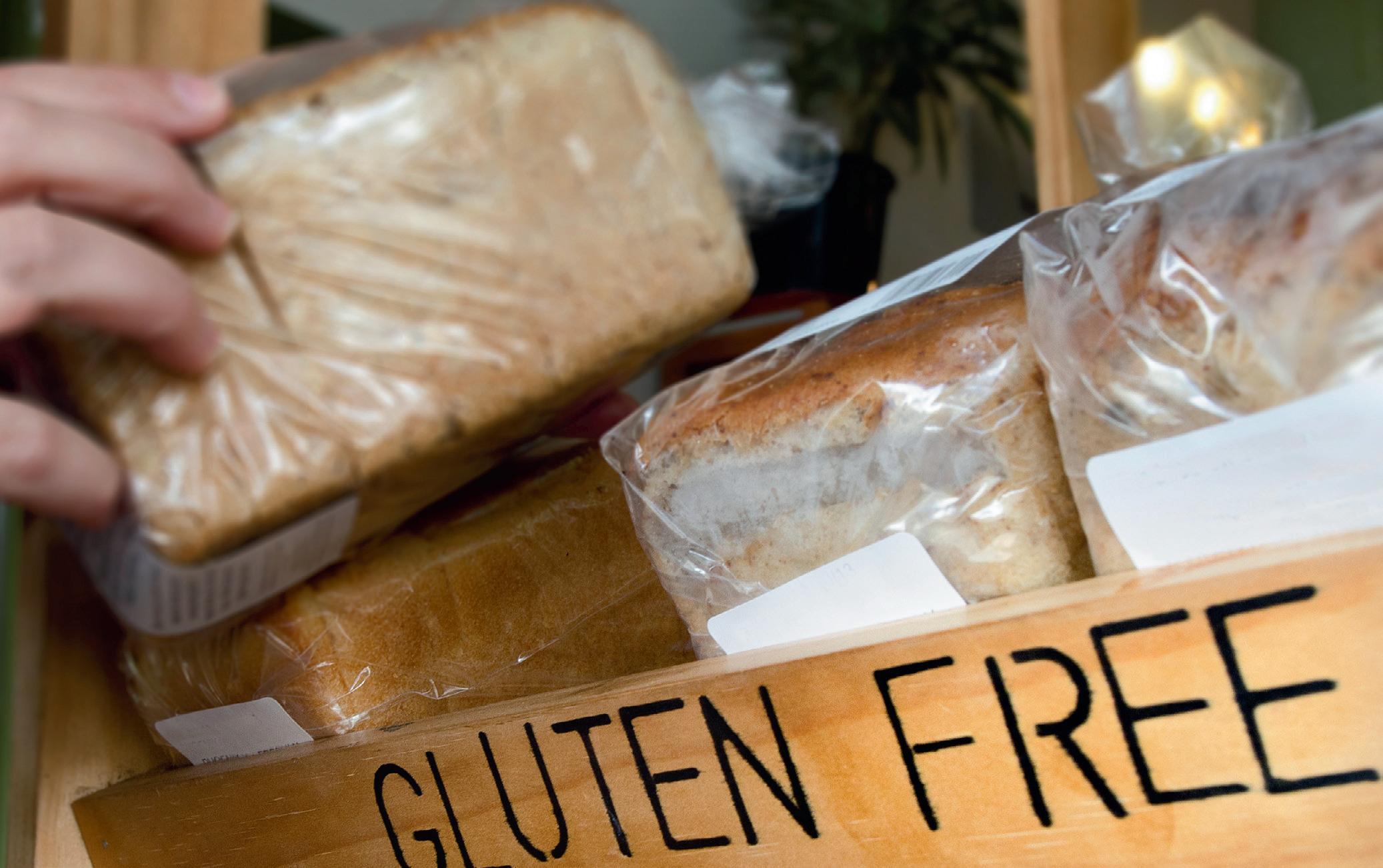
Miranda’s research team has been carrying out a nutritional analysis of gluten-free products as part of the Gluten 3S group, which is accredited for granting the ISO standard seal that can guarantee gluten-free products are actually gluten-free.
“In 2014, we published a fairly groundbreaking scientific paper,” Miranda-Gomez said. “In it, we compared 200 glutenfree foods with their gluten-containing equivalents. Nutritionally, they are not on a par with each other.”
Many of the gluten-free products contained more unsaturated lipids (or harmful fats) than gluten-containing ones, they were lower in fibre and their salt and protein content needed to be monitored. But the situation is changing all the time and the results of another study have just been published in the journal Foods
The proportion of coeliac individuals has not changed and remains at approximately 1%. However, the population has increased
and gluten sensitivities have also emerged, which means that when this group is also taken into consideration, the problem affects 10% of the population. “The industry has been aware of that,” said Miranda-Gomez. “So it has developed more products, which has allowed the industry itself to do more research and take other components into consideration. To a certain extent, this social and research team momentum has led to an evolution in the industry. And there has been a remarkable improvement.”
Pasta is a case in point. With GF pasta, the wheat ingredient is usually replaced with maize flour, which hasn’t changed in the last nine years. However, previously, the second most important ingredient was rice flour but this has now changed to millet. “This has had a positive effect on nutrition,” Miranda-Gomez said. “To produce pasta, you have to extrude it, and millet allows extrusion to be carried out using fewer lipids.”
In the case of non-solid products, producers use other strategies rather than just replacing the gluten ingredient. For example, with GF beer the gluten is broken down by the addition of enzymes during the clarification process (when suspended particles are separated from the liquid). “But this process has another limitation,” Miranda-Gomez added. “Harmful molecules may go unnoticed during routine analysis. Members of the Coeliac Association sometimes tell us that gluten-free beer disagrees with them.” So a new line of research has been opened to analyse the problems with these beers.
As far as Miranda-Gomez is concerned, the GF topic is clearly a broad one and needs further research into environmental factors.
“We want to find out the environmental impact of glutenfree food. They tend to have a greater impact than the rest, because some ingredients need to be imported from abroad, for example. That impact would need to be reduced. For example, the sourcing of millet needs to be explored,” Miranda-Gomez said.


this autumn.
Chobani has launched a range of creamy yoghurts made from natural ingredients with no sugars or sweeteners added, available in mixed berry, mango passionfruit and vanilla bean flavours. www.chobani.com

Monnet Cognac has launched in Australia with a full range featuring spirits that can be enjoyed alone or as part of a cocktail. www.monnet.com
Norco has launched two chilled plant-based milk products — P2 Pea Protein and Oat Mylks. www.norco.com.au

Asembl is mixing up Streets’ Golden Gaytime with Green’s again for the launch of Green’s Golden Gaytime Pancakes and Green’s Golden Gaytime Cupcakes. greensbaking.com.au

Waterdrop has launched hydration microdrinks to encourage Australians to drink more water. The range features several fruity flavours to be added to water. waterdrop.com.au
Nestlé has unveiled a milk alternative that combines a blend of oat and fava with a mild, nutty taste and nutritional value. www.nestle.com.au/en

Westwick-Farrow Media
A.B.N. 22 152 305 336 www.wfmedia.com.au
Head Office Unit 7, 6-8 Byfield Street, North Ryde Locked Bag 2226, North Ryde BC NSW 1670
Ph: +61 2 9168 2500
Editor: Carolyn Jackson wnift@wfmedia.com.au
Editorial Assistant: Vanessa Boumelhem
Acting Publishing Director/MD: Janice Williams
Art Director/Production Manager: Julie Wright
Art/Production: Linda Klobusiak, Marija Tutkovska
Circulation: Dianna Alberry circulation@wfmedia.com.au
Copy Control: Mitchie Mullins copy@wfmedia.com.au
Advertising Sales Manager
Kerrie Robinson
Ph: 0400 886 311 krobinson@wfmedia.com.au
Nikki Edwards Ph: 0431 107 407 nedwards@wfmedia.com.au
If you have any queries regarding our privacy policy please email privacy@wfmedia.com.au
NOTICE:
made by the source.
Proven to increase efficiency in high value dairy products and flavourings and essences
From pharma to food, cosmetics to chemicals, Fluid Air delivers big ideas that help you preserve active ingredients, accelerate production, and reduce waste - all with cost efficiency in mind.
Our innovative PolarDry® technology utilises milder temperatures to produce powders, leading to large efficiency gains for your business.
Electrostatic spray drying is a low-temperature drying technique that combines dual-fluid atomisation and electrostatic charge in a single-step process for conversion of liquid feed into powder.

Fluid Air has the range to suit the size and needs of your business with machines tailored for R&D, feasibility studies, as well as small, medium, and large-scale commercial manufacturing.
For enquiries, contact us at mark.condro@spray.com.au



